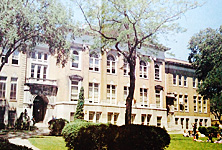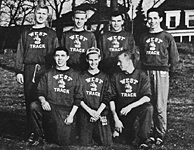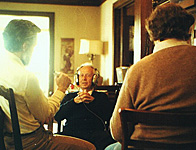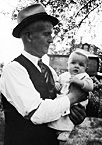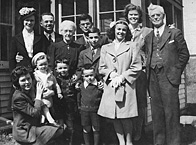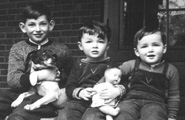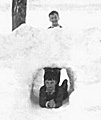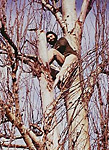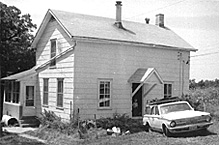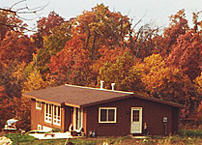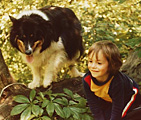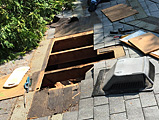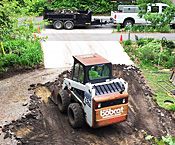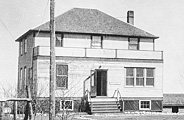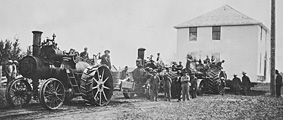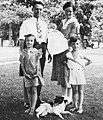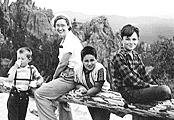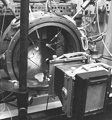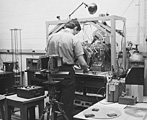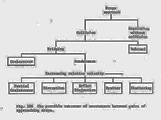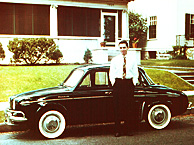prompt responses by Robert W. Park | ||
| 1 The Forgotten Birthday Jan. 1, 2024 | ||
|---|---|---|
|
On Christmas morning in 1954 my brother James and I awoke to find, by the Christmas tree, a new bicycle for me and a new toboggan for him. My immediate reaction was a powerful sense of dread. Our father was a frugal man, and such gifts were totally out of character for him. A year earlier our mother had a radical mastectomy. Our father told me the doctors thought they had gotten all the cancer, but in recent weeks our mother had been sleeping in a special chair Dad had placed in their bedroom. At times at night I heard her cry out in pain. Less than 4 weeks after Christmas I was called out of class at West High School, where I was a 14 year old sophomore. James and I were brought to the hospital to "say goodbye" to our mother. Her face was a waxy yellow, and she seemed unconscious of the presence of anyone in her room. Our older brother Douglas had been summoned to Minneapolis, and the next morning he told me our mother had died. My 15th birthday was 3 weeks later. Neither I nor anyone else seemed to remember it. A short time later I went to a barber shop for a haircut. The barber asked how old I was, since he charged more for boys once they reached 15. After a long pause I realized I couldn't remember whether I was 14 or 15, and I gave him the wrong answer. | ||
| 2 Family History in the Trash Jan. 16, Nov. 30, & Dec. 27, 2024, Sept. 11, 2025 | ||
|
On the last day of 1949 our family spent the night in a hotel or motel in Minneapolis as newly arrived Canadian emigrants. The following day was our first in our new home in a new country. The house was at 1804 Humboldt Ave. Though it looked dingy on the outside, the inside showed it had been an upper crust residence, with servants' quarters on the 3rd floor and a small building in back that must once have been a stable, with a hayloft above, now converted to a garage with a large sliding door for a single car. That first winter we had no car, and Dad sprayed water on the garage floor to make a small skating rink for us kids. In front the house had a large screen porch with windows looking out onto it from the front entryway, the living room and, in between, my Dad's office and library. One wall of that last room was covered by bookshelves almost floor to ceiling. I say almost because at the very bottom was a row of single drawers just tall enough for the hundreds of black and white photo prints, standing on edge, that my dad had taken over the years. He devoted one drawer entirely to these prints. If we'd had a fire, that drawer might have been the first thing we saved. There was no fire, but in January 1955 my mother died, and in September 1955 Dad remarried. Evelyn was Dad's 3rd wife. At age 42 she had never been married, but it was years before us kids were allowed to know her age. Her arrival meant major changes in our household. The living room was re-carpeted and made off limits to my brothers and me. The picture of our older sister Betty from Dad's first marriage, taken about the time she graduated from high school, which had hung on the wall at the foot of the stairs for years, came down. Word reaching us kids was that Evelyn did not want visitors to know that Dad had been married before. Then the day came when, while Dad was out of the house, I discovered the wastebasket in the library full of his black and white prints. Never one to throw things away, I was sorely tempted to salvage at least some of the prints. When she heard about it later Betty said she would have given her eye teeth for them. But I expected Dad would be angry if I interfered with his decision to dispose of this large part of our family history. He did save out a few prints for us kids in which we or our mother appeared. On the question of what I would save if my house was on fire, photo prints of course come to mind. There are two small drawers of prints in the bedroom that could be pulled out and saved, and there are 5 photo albums with color prints from the years before digital photography. The album cover colors, progressing through the years, are brown, green, red, white and blue. But these prints would not be top priority since I have gone through them and scanned many for inclusion in the people galleries section of our Park Family Scrapbook website. What have not been digitally preserved are family 8 mm films and audio cassettes. There are 6 of the 8 mm film reels, starting in 1981. While these reels include a few movie sections, they for the most part contain single shots, serving like a low resolution version of digital photography. There are hundreds of frames of family members and places we visited where we may have no other photographic record. There are also animation sequences produced by a young Robin (my oldest). Audio cassettes include concerts and music performances by family members and a series of recordings of the kids. The latter cassettes were numbered from 1 to 55, starting in 1979 and continuing until 1990. In preparing to write this story I was unable to locate tapes 19 through 50, but I finally found them in November. They are in a beige colored plastic case that I put in the living room to hold up the radio next to the couch. That's definitely something to grab in case of fire.. 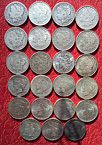 Also on hand are 8 3-inch size audio reels on which my sons made some recordings on my reel-to-reel machine in the 1980s. We would also want to save those until digital copies are made. I have placed these, the numbered audio cassettes found in January, and the 8 mm movie reels in a small red suitcase under a dresser in the bedroom, easy to spot and grab in case of a fire. Something else I'd want to save is my coin collection, in a small case I've placed on top of the red suitcase. The silver dollars at right are a sample of that collection. Coins from a basement shelf that I added to the suitcase in September 2025 can also be seen when you click on that photo, Indian head nickels from the 1930s and pennies from 1943 that were made without copper when copper was needed by the military during World War II. We kids called them "lead pennies" but they were really made of low-grade steel coated with zinc. Other things I would want to grab are the 3 external hard drives connected to my computer. One has our radio station music library, currently containing 97,313 music files. | ||
| 3 The Steam Tent Jan. 22, 2024 | ||
I will start this story with two pictures taken in Brownsville Ontario, the little farming village where I was born. These baby pictures show two proud parents, my mother and my father, but the two babies are not the same. My father is holding me when I was 4 months old, but my mother is holding 4½ month old Winnifred, her first born, the sister I never knew. Winnifred's picture was taken in August. In November she came down with pneumonia, and despite treatment with steaming, oxygen and sulphanilamide injections, she died in early December, 1938. My mother's baby book for Winnifred is posted here. I arrived in February 1940. In my earliest memory I am lying in my crib with a white sheet across the top and and down the sides. The light coming in from above suggests that it is a sunny day in the outside world. I must have told my mother about the memory, and she probably explained that steam was being let into the enclosed area. With Winnifred's death still fresh in their memories, my parents probably worried over any sign of respiratory infection in me. I may have gotten the steam tent treatment more than once. Perhaps at an early age I was already experiencing vasomotor rhinitis, my lifelong incurable (but largely harmless) disease commonly known as the runny nose disease. | ||
| 4 Why I Hate Shopping Jan. 22, 2024 | ||
|
From an early age I hated to see things wasted, and I have long been turned off by the materialism promoted by advertisements on television and in other media. For me the best advertisements are ones that make fun of advertising, or ones that unintentionally go wrong. For example, I remember a live car commercial on local TV where the pitchman was extolling the headroom in the car he was advertising. To illustrate, he opened the car door and got in, promptly bumping his head on the door frame as he sat down. The disgusted look on his face was priceless. Then there was the mock ad prompted by the fact that some detergent commercials on black and white TV used white and blue shirts to illustrate that the detergent you were supposed to buy got one shirt whiter than the competitor's product. The mock pitchman held up the two shirts and asked a volunteer "which shirt is whiter, Mrs. Jones?" She pointed at the wrong one and said "the blue one," then asked "when will this appear on TV?" The pitchman's weary response was "not for a long time, Mrs. Jones." Then there was the car ad on national TV, for Ramblers I think. A gang of youths was surrounding a new model while the leader extolled its virtues, saying "take this for example," indicating the bumper or some other part. A gang member immediately put his hands on the part and had to be told "not now dummy." That ad disappeared from TV quite quickly. However, being deeply distrustful of advertising is not the main reason I hate shopping. That comes from personal experience, especially during the Christmas shopping I felt obligated to do as a youth. I picked a serving spoon that was the wrong pattern, chose a tie my older brother would be embarrassed to wear, etc. Once I bought a rubber pad that I noticed his old car needed by the gas pedal, only to find that he had bought himself just such a pad before Christmas. He made a show of pulling out his new pad and sticking mine in, but that did not alleviate my embarrassment. To this day, I find it far more satisfying to reuse something old than to buy something new. | ||
5 Vacation Memories Feb. 1 & May 13, 2024 Click on photo | ||
|
Delhi, Ontario
The first 9 years of my life were spent in Ontario, first in the small farming village in southern Ontario where I was born, then in a city not far from Toronto, and finally farther north in a town on the Ottawa River that had been newly constructed for the families of workers at Canada's first nuclear reactor. During those years the most common destination for our family vacation trips was the town of Delhi Ontario where my mother's parents lived. Their property was adjacent to a railroad line, and the passing trains are the first thing I think of when I remember those visits. Initially, at night a passing train would wake me up, but I soon became accustomed to the sound and was disappointed when I found I was sleeping through it. The rail line was on raised ground, and during the day us kids would wave up at the locomotive engineers when a train came through. We were delighted when they noticed and waved down to us. The Delhi house was also memorable for the smell of baking bread. It was something my grandmother seemed to be doing every time we visited. Then there was the railroad underpass for the road in front of the house. It was so narrow that only one car could pass through at a time, and it was hard to see if a car was approaching from the other side. As a result, the standard procedure was to honk your horn before entering to let any other approaching driver know you were coming. These visits continued on occasion even after our family moved to Minnesota. There was one visit when I was really into seeing, at age 13, how high I could jump. I set a sawhorse out in the yard and started piling things on top of it. My little brother Warren got into the act by getting under the sawhorse on hands and knees. The result was the photo you see of me flying through the air which I guess my father took.
Delhi was also the site of another memorable experience, my first time driving a car. Across a large flat area from the house was a garage which, at one time, must Port Rowan, Ontario
Wesley was a mechanic and had a collection of old vehicles on his property. One was Grandfather's old Dodge, the first car I had diven. (I snapped a picture of it with my oldest son Robin.) One of the last visits to Port Roway was for the memorial service for Wesley's wife Irene after she died in 2005. At the reception some people who had not seen Wesley for a time mistook me for him, since we both had long hair and a beard. Our final visit to the Port Rowan house was after Wesley died in 2009. We were among the cousins who helped their son Jonathon clear out the house. Jonathon, using his middle name Craig, has lived in Japan for many years and much of the old correspondence and numerous photographs from Wesley and his father that had been stored in Wesley's basement came to our house in Madison for storage. Fairground, Ontario We sometimes visited my paternal grandfather's house in Fairground Ontario, but those visits were less frequent than our visits to Delhi. Something I remember from one of those childhood visits is the powerful smell that greeted us when Grandpa was raising hogs. On a later visit I remember seeing Grandpa working on a wooden platform in front of the front door. He had a level with him but the platform was clearly sloping away from the house. Dad noticed this and went over and turned the level around, showing Grandpa that the level was defective. Grandpa was annoyed, and went back to continuing the work as he had been doing it. Mexico
A few months after we moved to Minnesota my father bought a new two-tone 1950 Nash. That car was to be our means of transportation for family vacations for years to come. One of these, when I was 12, took us all the way to Texas and, for about 1-1/2 hours, across the border into Mexico. That visit was memorable because at a shop in Mexico I bought my first Mexican yoyo. On the way back to the car we met a Mexican kid who saw my yoyo and motioned for me to let him try it. I did, and he showed us how to flip the Lake Superior North Shore
Yosemite National Park A few years later I was camping in Yosemite National Park in California. Foolishly, I had left my backpack, containing a jar of honey, on the site's picnic table when I got in my tent for the night. In the early morning hours I was awakened by noises which turned out to be a bear about to make off with the backpack. I scared it off by banging on a pot, though from its casual departure, it didn't really seem all that frightened. Point Reyes, California

Matanuska Peak Trail, Alaska The previous summer I had tackled the Matanuska Peak Trail on a visit to Alaska. I did not make it to the peak, but above the 2200 ft level I got to meet a marmot. You can see him here eyeing me from his big rock. (More photos from that trip are posted here.) Finally, here is a memory from my life's longest trip, my trip to New Zealand with Barbara in 2015. We took a trip across Lake Wakatipu in the TSS Earnslaw, a coal fired steamer. At over 100 years old, it is one of the last of its kind. We got to see coal being shoveled into the boiler and read about the ship's history. (Some photos from the New Zealand visit are posted here.) Many Minneapolis Visits After my move to Wisconsin in 1961 by far my most common destination for holidary trips has been Minneapolis, a relatively short drive from Madison. After my brother Warren bought a house across the street from Poderhorn Park, I enjoyed 4th of July trips there to take in the fireworks displays put on by the city using the island in Powderhorn Lake. Once I had children Christmas visits provided a wonderful time for his kids and mine to play together, celebtating both Christmas and New Year's Eve. Our family times together from 1982 on in summer and winter are shown in The Minnesota-Wisconsin Connection gallery. A Thanksgiving visit 20 years ago provided the context for one of my poems, Ice Pebbles Dancing. | ||
6 Work You Can Believe In Feb. 5, 2024 & Jan. 8, 2025 | ||
|
In 1960 I had a summer job at Dow Chemical Company in Midland Michigan. At the time I was studying chemical engineering as an undergraduate at the University of Minnesota. Dow was running a "Summer Engineer" program for students like me, and as it happened I had a distant relative working for Dow named William Robb Roy Park. He and his wife invited me to stay with them and their children for the summer. At work the father was known as "Bob Park," and he enjoyed confusing coworkers I met by offering to introduce them to "Bob Park." Dow's goal was to encourage engineering students to come and work for them after graduation. The summer experience had the opposite effect on me. The one thing I remember from the speaker at an orientation session we were required to attend was when he said "profit is not a dirty word." Five years later Dow bid on and won a government contract to make napalm for the military to use in Vietnam. "Profit" at Dow was not only dirty but shameful. I decided that working in the public sector was a higher calling than working in the private sector, and have stayed away from profit motivated employment ever since. I started graduate school at the University of Wisconsin in 1961, and soon found the campus to be a hotbed of information outside the classroom for anyone concerned about social problems in our society and problems elsewhere on our planet. The more I learned about these problems the more I was inclined to set career goals aimed at working to solve them. One thought was to get involved with technical air to underdeveloped countries. However, when I learned about conditions in Mississippi, our poorest state, my focus shifted to problems closer to home. The summer of 1964 was Freedom Summer in Mississippi. One of the 3 civil rights workers killed at the beginning of the summer by the KKK, with the assistance of local law enforcement, had been (I learned later) a student at UW-Madison. I took the summer of 1965 off from graduate school to serve as a volunteer for the Mississippi Freedom Democratic Party, mostly in Jackson, and interrupted my graduate work again to return to Mississippi in 1967 to teach for a semester at Tougaloo College, a historically black campus that was a center for civil rights activity. When I finished grad school in 1970 Ralph Nader was making headlines with his work on consumer protection and environment issues. One of his projects was to organize public interest research groups (PIRGs) on college campuses across the country. His idea was to fund these groups through an addition to student fees, collected when students registered, unless a student took the initiative to decline to pay the fee. An organizing committee for a Wisconsin chapter, WisPIRG, was set up in Madison. About 100 students on the Madison campus got involved in collecting student signatures for a petition to the UW administration asking for this funding scheme. I was hired by the organizing committee as Statewide Coordinator, to be paid if and when the funding scheme was implemented. In that role I visited a number of campuses in the UW system in other parts of the state, where petition drives were also underway. On the Madison campus they collected about 11,000 signatures, but that was less than half of the student body. We met with the Dean of Students anyway, since he had indicated verbally that he would support us, but when we mentioned his verbal assurance he asked "did you get it in writing?" Also invited to the meeting, perhaps by the dean, was the then current editor of the Daily Cardinal student newspaper. She promptly described Nader's funding scheme as "fascist." So our effort failed, and I was never paid except for a small amount to cover my travel expenses. So what was next? Throughout grad school I had a research assistantship which was funded by a grant from the federal air pollution control agency that existed before the Environmental Protection Agency (EPA) was formed. Looking for a public sector job in air pollution control was an obvious option. The new EPA had started a program to assist state environmental protection agencies by hiring engineers for a year and assigning them to work for different states. I landed one of these positions and was assigned to the Wisconsin Department of Natural Resources (DNR). Before my year was over the environmental protection folks at the DNR I had decided they wanted to hire me. I had reservations about the DNR, wondering if its bureaucracy would be hard to put up with, but decided to give it a try. My fears were realized when my boss in the air management program submitted a performance evaluation for me rating me as "excellent" in most categories. The response from the DNR personnel staff person, who had never met me, was "does he also walk on water?" My boss brought the feedback to me and apologetically explained that he would need to downgrade his evaluation to make them happy. Never-the-less, I ended up staying in the DNR job until I retired at age 66. Our air pollution control work at the DNR was mostly aimed at meeting federal requirements, but needed changes in federal law were often delayed by politics. On those rare occasions when there was some consideration of state requirements that went beyond the federal requirements, I was glad to be able to side with those involved in such efforts. | ||
7 Books from Childhood and Dotage Feb. 12, 2024 | ||
|
When my boys were little, reading them bedtime stories was my favorite part of our nightly bedtime ritual (topped only by singing a song when requested). A picture book I particularly liked was The Little Engine That Could. I liked to stretch out "I think I can, I think I can" with increasing speed as the engine struggled up the hill. From my own childhood, I don't remember my parents ever reading me bedtime stories during my preschool years. However, when I was old enough to wash the dishes, I remember my father sitting in the kitchen and reading to my siblings and me as we cleaned up after supper. Two of his favorite books were Rabbit Hill by Robert Lawson and Wild Animals I Have Known by Ernest Thompson Seton. When I was old enough to read chapter books on my own, horses were a favorite topic. I think I read everything available before I started high school in Walter Farley's Black Stallion series. I also liked to read nonfiction stories about Native Americans such as one about Chief Joseph of the Nez Perce as he led his tribe in an epic attempt to escape to Canada while being pursued by the U.S. Cavalry. As an adult, for many years I read very few books that did not contain information I needed for a task at hand. Then, during my retirement years, I took up the practice of joining my wife in reading in bed at night until drowsy. Books for this purpose have almost always been entertaining fiction. Favorite authors have been Canadian science fiction writer Robert J. Sawyer and detective story writer Robert B. Parker. I particularly enjoyed Sawyer's neanderthal and WWW trilogies and Parker's Jesse Stone series. My current bedtime book is nonfiction - Freedom Summer by Bruce Watson. It relates to the summer of 1965 that I spent in Mississippi as a volunteer for the Mississippi Freedom Democratic Party. | ||
8 Children and the News Feb. 19 and Sept. 2, 2024 | ||
|
Much has changed during my lifetime on how children hear the news. When I was born in February of 1940 Canada had already sent troops to Europe to fight during the Second World War. During the war years the family lived first in the small farming community of Brownsville Ontario where my father was a country doctor and later in Whitby Ontario while my father took on healthcare responsibilities at a nearby munitions plant. During those years the family's main source of news was probably the newspaper. Newspapers were for grownups, and we children would have heard current news mainly from whatever parents chose to share at the dinner table. News could also be seen and heard at the movie theater where newsreels were commonly shown before the feature film, but I don't recall seeing my first movie before the end of the war. In 1945 we moved to Deep River Ontario, and around that time we acquired a large floor model combination radio and record player, with a drop down record changer for the 78 rpm vinyl records. News then became available from the regular radio network newscasts, but I don't remember my parents making a regular habit of listening to the news. No news of the day that my older siblings or I heard on the radio sticks in my memory. Our family moved to Minneapolis Minnesota at the end of 1949 and it was during the mid 1950s that my brother James and I got our first radios. Our father picked up a couple of old tube radios with no cases at a Goodwill or similar store for us. I picked the smaller one and spent a good deal of time making a plywood cabinet for it. I sanded it smooth and applied a coat of varnish with a reddish hue. In Minneapolis we had a larger house and James and I had our own bedrooms for the first time. This meant that I could listen to my radio in my bedroom whenever I wished, but I was more interested in music than in news. This was the time when stereo broadcasts first became available. At first it was just stations that broadcast in both AM and FM that experimented with this new idea, airing one channel on AM and the other on FM. I recall that my father did not think much of the idea until he realized, to his surprise, that what came over the two channels was not the same. My first contact with television was when I was invited to watch a weekly program, probably The Lone Ranger, at a classmate's house within easy walking distance. It became a regular weekly event until the day I showed up only to find they had forgotten about me as they prepared for a family outing. I never went there again. It was not until I was in high school that we got a television set in our own house, a table model in a metal case. Everything on the screen was in black and white of course. My younger siblings and I were not allowed to watch it on school nights, and it was entertainment shows we sought on weekends. Minneapolis had two daily newspapers back then, and I had a paper route for the afternoon paper one summer. Newspaper headlines provided a ready source of current news. I guess it was the afternoon paper we got at our house. One day my father came to my bedroom to tell me that my stepmother had found something about me in the paper. It turned out to be a letter to the editor from a woman complaining about the behavior of an unnamed employee of the Minneapolis Park Board, and about inadequate facilities at one of three places they operated at Lake Calhoun. The only connection to me was the fact that I had a summer job at a different Park Board facility, at the main beach on Lake Calhoun. I learned later that someone who at times worked with me at the main beach had been the cause of the letter. He had been assigned to work selling food and beverages from the small trailer the Park Board stationed at a smaller beach on the other side of the lake. At that beach they had an outhouse that only lifeguards were allowed to use. The single employee selling things from the trailer was instructed to temporarily close the panel over the sales side of the trailer and pee in a paper cup if he had to go. This was what he was doing when the woman who complained came around to the back door of the trailer and yanked it open. Not surprisingly, his response to the interruption had not been polite. Speaking of newspapers, for a time I had a job delivering a free weekly paper that was mostly advertising. I pulled the papers around from house to house in a wagon. One day a man walked by me while I was a few steps away from the wagon. I turned back toward him in time to see him surreptitiously sneak a paper out of the wagon. His disgust at seeing what he had stolen was obvious, though he did not seem to notice that I was observing him. I could have called out "you're most welcome sir," but of course I did not. All of this was before the internet, which now brings young and old alike a wealth of information, both true and false. Children need well developed critical thinking skills to distinguish between the two. Local news has become harder to get as media outlets have undergone consolidation into the hands of fewer and fewer corporate multimillionaires. Efforts to restore locally controlled local news have included podcasts and low power radio stations like the one that started in our garage, WIDE-LP. I have programmed what that station broadcasts since 2008, making use of podcasts from near and far when broadcast permission has been granted to me via email. Our weekly schedule, which can be seen here, includes brief news programs from Public News Service, Democracy Now! each weekday morning (59 min.), and CounterSpin once a week (29 min.). Other weekly podcasts that I broadcast often contain less current news as it relates to a particular topic. I sometimes listen to what I'm broadcasting on the radio station, but I mostly get my news from TV programs such as the PBS News Hour, BBC America, and the first 16 or 17 minutes of CBS newscasts at 7 AM and 5:30 PM, which can be heard without commercial interruption. (Once the commercials start I change the channel or turn off the TV.) If I want more detail about a current news story I will often look for it on the internet. | ||
9 Things that Matter March 6, 2024, July 24, 2025 | ||
|
"Things" is a word that can cover anything from the profound to the trivial. It's just physical possessions I'm writing about here. Even the most avid anti-materialist has things of this sort that he or she uses. The things I have range from the replaceable things I need and use every day to things I rarely use but which are irreplaceable. My son Ian gave me a computer that I use every day. I'm using it now to write this. But one day it will die of old age and not be mourned as it is replaced. Ian also gave me a Trek bicycle that he bought 2nd hand. It is the best bicycle I've ever owned, but with its high pressure tires it has had more flats than all my other bikes combined. I expect it to last longer than me, so I need to decide who to leave it to in my will. In the meantime, it has been replaced with my wife's old bike for my local everyday use. Last year my wife and I had a top of the line heat pump installed with an associated high efficiency gas furnace. It will reduce our household contribution to global warming, but it only has a 10 year guarantee. 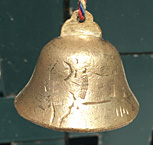 On the other hand I have things from our family history that are irreplaceable. Children change most rapidly during their growing years. I have many photographs and tape recordings of our children from those years. Copies have been made of some but not all of them. At the end of Family History in the Trash I mentioned the little red suitcase containing some of these items, conveniently located where it can be grabbed in case of fire. Something from my mother's childhood that I added to that suitcase in July of 2025, after finding where I had left it hanging on a basement wall, is a little hand carved brass dinner bell (shown at right) that she brought back from China. She spent most of her early years there, from age 2½ to age 13, with her missionary parents and their growing family. | ||
10 Colours of the Season March 11, 2024 | ||
|
Born in Canada, I guess I have always liked snow, and that's the Canadian spelling of colors in the title. In winter my favorite color is white, the white of fresh snow and of hoarfrost. As spring arrives I am cheered by the reemergence of green as the new leaves sprout from buds and push out of the ground, but the green soon becomes a backdrop for the brighter contrasting colors of flowers in many hues. Summer brings the colors of late blooming flowers, blue skies and puffy white clouds on long sunny days, and sometimes a spectacular sunset in shades of orange. In autumn the chlorophyll in the leaves of trees breaks down to reveal the underlying orange, yellow or red fall color characteristic of each species. The maple trees with the brightest red leaves are my favorites. When I was a boy in Ontario we had no officially adopted flag of Canada. It was not until I was a graduate student at the University of Wisconsin years later that Canada adopted its national flag with a red maple leaf in the center. | ||
11 Mississippi Memories March 20, 2024 | ||
|
In January 2024 I participated in a panel presentation at Prairie Unitarian Universalist Society on "Answering the Call for Civil Rights," an audio recording of which is available here. The order of service for the Sunday program, available here, shows that a song I had suggested, Pete Seeger's "Those Three Are On My Mind," was sung as the prelude by my wife and another member of the congregation. The song is about the 3 young civil rights workers who were murdered in Mississippi by the KKK and local law enforcement at the beginning of the 1964 Freedom Summer Project. In connection with the program I had checked out a book from the library titled Freedom Summer: The Savage Season of 1964 That Made Mississippi Burn and Made America a Democracy by Bruce Watson which I subsequently read. Published in 2010, the book brought back memories of people I had met and filled in many details about the murders of the 3, two white and one black, I had not known. It also described murders in Mississippi of others who stood up for the rights of black people, murders that never made national news because the victims were black. The book concluded with a description of the substantial progress that has been made in race relations in Mississippi over the years since that summer. A highway has been named in honor of the 3, and the state marker shown at right has been installed at the site of their murder.
My time in Mississippi began the in 1965, the year after Freedom Summer. I interrupted by graduate work at the University of Wisconsin to go to Mississippi as a summer volunteer for the Mississippi Freedom Democratic. Soon after arriving I opened a small account in a black owned savings and loan association in Jackson, so that I would have a safe location for a little spending money. That proved to be fortunate. Three days after arriving I joined more than 400 others in a march on the capitol. It is hard to imagine a more peaceful march. We stayed on sidewalks, stopping for traffic lights at intersections to let the cars pass by. Nevertheless, we were halted by police. I remember the long line of marchers, mostly black, along the sidewalk as the police announced over a megaphone that anyone who did not want to be arrested should step out of line. I did not see anyone who did. The belongings of volunteers from other states were held at the Delta Ministry Mount Beulah center while we were imprisoned. When we got out it was immediately clear that security there had been loose. Hangers on around the movement had gone through our things and stolen whatever they found of value. One girl was distraught to find that $200 cash she had brought for bail money was gone. I believe she soon returned to the north. I inquired about a small portable radio of mine that was gone. A local black man heard me, and the radio miraculously appeared. I took the radio out of its leather case and found that a bill I had folded and placed in the bottom of the case was still there. Seeing the money, the young man immediately started talking about how he had rent to pay, looking for a handout. A Freedom Democratic Party leader who was there intervened, sending the hanger-on away. I spent a night or two in a "shotgun" building used by project organizers, in a sleeping bag on the floor. The name for this kind of building came from its shape - two front entrances with a series of rooms straight back from the entrances without connection across the center wall. While there I was awakened after midnight by a series of phone calls clearly intended as harassment. The office was not open and no one else was there. Hanging up did no good because they just called back. Finally I stayed on the line and asked the caller if he and his buddies were enjoying their beer. Apparently they were. After that either they were tired of their game or I took the phone off the hook, I don't recall which, and I got to sleep the rest of the night. While staying at that location I left my things there during the day. These included a research notebook and notes I had brought with me, in case I had time to work on getting the notes entered into the notebook. On arriving back for the night I found these were gone. Fortunately I found them is the trash can. A well-meaning volunteer had found them and thrown them out, not realizing what they were or who they belonged to. During the day I canvassed for a Freedom School that was being started in the Jackson neighborhood. I was called "Mr. COFO man" because the previous summer had seen volunteer work there by the Council of Federated Organizations, one of the groups mentioned in Bruce Watson's book. I will never forget one small white haired black woman who I told about the Freedom School. Looking up at my white face, which she must have associated with the ruling class that she had lived under her entire life, she ask "Do I have to go?" Shocked, I responded "of course not," to her relief. Another memory from that time is the young girl who liked to show off for her friends (and anyone else) how she could pry the cap off a Coke bottle with her teeth. We out-of-state volunteers were included in some mass meeting with local black activists. Some of the more radical activists thought white volunteers should not have been invited to the state, while others expressed the view that black and white together, “like salt and pepper,” was the way it ought to be. There was some social time with other volunteers. One white volunteer had brought his trumpet with him, and I got to go with a racially mixed group when he was sitting in with black musicians at a black night club in the Jackson area. It was late at night and I was having trouble staying awake. At one point, as I was dozing off, I was awakened by a hard squeeze on my knee. White police officers had come into the night club to check things over. Apparently if I was asleep it might have given them an excuse to arrest someone. There was also at least one occasion with some dancing. That may have been the evening when I was in a car full of black girls one of whom was holding a fussing baby. They decided to hand the baby to me and the baby quieted down. The girls all said um-hmm, deciding that the experiment proved something, I'm not sure what. Maybe the baby was used to being held by a white father. For a short time I was housed with a couple of other volunteers in a middle class black home where they had set up cots in their dining room. Ready to serve us breakfast, our hostess knocked on the dining room door to ask if we were up. Just awakened, a young white male volunteer who had slept in nothing but undershorts sat up and said "yes." Our hostess came in and was not pleased with what she saw. This may have been the neighborhood in which I was walking with a young black man at twilight when a pickup truck pulled up next to us. Out the open window the white driver snarled "nigger lover" at me before driving off. My black companion was much more upset by the incident than I was. Later I was the sole volunteer housed for an extended time with a black family in a poorer section of town. I had a comfortable couch to sleep on and a bathtub to bathe in. I remember there was no hot water, but with the hot Mississippi temperatures the bath water was not that cold. The family had a teenage daughter who joined a picket line at a local grocery store calling for black workers to be hired. I heard from another volunteer that the picketers had been arrested by the police. When I returned to the house I asked the mother if she had heard about her daughter. Her reaction was one of panic. I hastened to assure her that her daughter was ok, she had only been arrested. My snapshots from the summer include one of picketers. On my last night with the family they insisted that I sleep in a bed that had just been vacated by a grandmother. The bed was in a room where the floor was sloping rather steeply, making the bed slope strongly as well. It was my least comfortable night. I spent some of my time outside the Jackson area. One Sunday I attended a small rural church service in a community meeting room where I believe I was the only white person. During his talk the preacher made note of my presence as a civil rights worker and asked if I had anything to say. I said no, thank you. He was clearly pleased at my polite response, and probably not displeased that I was not going to horn in on his pulpit time. After his sermon the collection plate was sent around, that apparently being how the preacher was paid. Seeing that an unsatisfactory amount had been collected, the minister sent the collection plate around again. Then after the service he departed in a large chauffeur-driven car. In August, on the day I was to board the train to return to my neglected graduate school work in Madison, I was with a middle aged black woman who expressed surprise that I was leaving then. She may have been a Freedom Democratic Party candidate for office. I asked "do you want me to stay?" but got no request for a last minute change in plans. On the still segregated train I settled in the section occupied by black passengers. A black conductor suggested I might be more comfortable in the white section but I declined to move. He did not insist, and the other passengers in my section seemed glad to have me. Back in Madison, with my Mississippi memories still fresh, I found my fondest memories were yet to come. I soon met, recently arrived in Madison from Mississippi, the girl with the golden smile. A top graduate from Rust College, she was at UW-Madison to get her master's degree. When I learned that she was from Mississippi, the Mississippi connection was enough to overcome my usual shyness. Her smile was quite literally golden because her two upper incisors were gold. I think that made her shy about smiling. Of mixed black, Indian and white heritage, she described herself as “yaller,” imitating the southern dialect with which she did not speak. It turned out that we lived right across the street from each other. She had a first floor front apartment in a large apartment building facing the old house where I had a 2nd floor front bedroom. We could see when our lights came on in the evening, and once we got to know each other, she would sometimes come over when she saw my light on. We were only a block off of State Street, the main drag between the campus and the state Capitol. One of the things we enjoyed doing together was walking down the State Street sidewalk noticing people who seemed to be noticing us in an uncomfortable way as they approached. After they passed us if we could turn around suddenly and catch them staring back at us, we thought that was pretty funny. A memorable date we had was when she joined me for supper at the Green Lantern Eating Coop on University Avenue. The Green Lantern was a gathering place for social activists and radicals for all sorts. For the occasion my date wore a striking hairpiece that hung well down her back. She even came to Minneapolis with me once and met my parents, though a girl I knew from Minneapolis came with us. We weren't sure how my father, and especially my stepmother, would react if we appeared as an interracial couple. When she finished her Master's degree and I saw her off at the bus station, about to head back to Mississippi, I could see through the bus window that she was wiping away tears. Then, a few months later, I got a Christmas card with a note about how much she missed me. I did see her once again when I had a one semester appointment in 1967 as an assistant professor of mathematics at Tougaloo College, which is in the Jackson suburban area. We went to a play together at the college. But the last time I saw her she made me promise not to contact her again. Perhaps the fact that she had crossed the color line while up north was not something she wanted to share with her family or friends. I kept my promise, but I had not promised to forget the time we had together. She had (and has) an unusual first name which, out of respect for her privacy, you will not find anywhere in this little story. My curiosity has led me to occasional internet searches for her name. I have learned that she went on to Rutgers for her doctorate, that she married a handsome African who also has a doctorate, that they both got faculty positions at Jackson State College (now Jackson State University) where her faculty photo showed her gold teeth had been replaced with white ones, that they have a daughter who got married, and that they have a son who was just this year chosen as the Distinguished Alumni for 2024 for the Mississippi State University Department of Electrical and Computer Engineering. I also learned that she was, for a time, advisor to the student radio station at Rust College in Holly Springs Mississippi. I emailed the station once about a program they were airing, thinking it might be something I could use on our low power station in Madison. I never got a response from the station, but ever since then I have been on the email list of the NAACP organization for the state of Mississippi. They probably have no idea that I am 700 miles away. Tougaloo College is a small historically black private college near Jackson. You can see some photos from my time there here. I have mixed feeling about my experience teaching there. I knew about the college through their chaplain, Rev. Edwin King, who is mentioned in Bruce Watson's book. I was glad to be associated with a college with a history of involvement in the civil rights movement. When I arrived for my job the college president told me with some pride that the KKK had burned a cross on their lawn. The president and most of the students were black but most of the faculty members were white. (I only noticed one white student.) Sometimes students could be heard singing freedom songs on campus. Students had to pass a Mathematics requirement to graduate. Most of the students in my classes were there only because of that requirement. Never having taught before, I had to spend long hours in class preparation, leaving little time for anything else. Despite this, I felt exhilarated at being out on my own, making a living for the first time on a new campus, far away from student roots.
I had driven down to Mississippi in my used 1958 Chevrolet. Under Mississippi law I had to get a Mississippi license plates, even though I was only going to be working there As a private college, I guess Tougaloo was enrolling a relatively privileged student body. I posted hours when I was available to provide one-on-one help to students who were struggling with math, but not a single student ever came in, even though toward the end of the semester it was apparent that a number were failing. It was evident that some students were not making any serious effort to learn the material. Another math teacher, a retirement age white woman from the north, actually had her whole class reciting things aloud together, which I found to be a disturbing example of white paternalism. At one point I was asked to take over her calculus class while she was out sick. After explaining something in that class I asked if there were any questions. They asked me to go over what I had just explained again, and I did so. Later one of the students came around to ask if I could take over the class from their regular teacher, since I explained things. I could not, and she soon returned. A couple of years later, when I finally reached the end of writing up my doctoral dissertation and was nearing graduation from the UW-Madison, I contacted Tougaloo again. I learned that they were no longer interested in hiring me. It turned out that a girl in one of my classes had complained to the college president, claiming I had told her that I would give her a failing grade no matter how well she did on the final exam. I had never said that to any student, so of course her statement was a lie. I may have told her how well she had to score on the final to bring her semester average up to a passing grade. At any rate, I decided that I was not outgoing enough to be a good teacher at the college level, and chose a different career path. | ||
12 School Days April 1, 2024 Click on photo | ||
|
I thought of subtitling this piece "Tales of Trauma and Humiliation," but fear not dear reader, there will be some pleasant memories from my days in kindergarten through high school as well.
I attended 5 different public schools in two countries, beginning with kindergarten in Whitby Ontario. It was the fall of 1945. World War II was drawing to a close and my For the next 3 days I moped around, barely speaking to anyone. It was my older brother, who likely knew about this principal by reputation if not by personal experience, who guessed what was wrong. He must have told our parents. Many years later my older sister wrote about how, unbeknownst to me, after learning about the incident my mother paid an angry visit to the principal to confront him concerning his traumatizing behavior. Half way through that first school year the family moved to Deep River Ontario. There I was confronted with the first big decision of my young life. There was no kindergarten yet available in the town, newly constructed for the workers at Canada's first nuclear reactor. My mother asked me whether I wanted to wait until the following fall to enter first grade, or start attending the second half of first grade right away. I could not imagine what I would do all day if I was not in school, so for better or for worse I picked the second option. I think it was for worse. My mother had taught school before marrying my father, but the idea of her teaching me kindergarten until summer arrived was never mentioned. I guess the reason was because she was pregnant with my youngest brother Warren, who arrived that spring in April. One day I was in the nurse's office having my temperature taken. As usual for the time, she was using a small glass thermometer with a bulb of mercury at the end. She let go of it before it was securely in my mouth. I intercepted the falling thermometer with my foot, a natural thing for me to do. The nurse was very relieved that the thermometer had not hit the floor and broken. Another time I got into some minor squabble with a pair of twins in the washroom at the school. The 3 of us were sent to the principal's office for a lecture which didn't amount to much, but the principal concluded by turning to me and saying ominously "still waters run deep." On another occasion I was guilty of some behavior that resulted in the teacher sending me to the cloakroom, which was a partitioned area at the back of the classroom. As the class continued she apparently forgot about me. In my pocket I had a prized possession, a jack knife which had been given to me, perhaps as a class gift. Eventually another student approached the cloakroom. Employing a very foolish attention getting plan, I opened the knife and held it high in a statue-like pose with my eyes crossed. The student immediately ran and told the teacher "He has a knife!" I guess I had some lame response like "He knew I was kidding." I think the class was over by then. It was a stressful time as I tried to catch up with the other students. We had notebooks with the multiplication tables on the back cover. It seemed the others knew multiplication up to 12 times 12 which was all new to me. Both teachers and parents seemed to place importance on homework, and I took my homework assignments very seriously. As a result I was stunned one Thursday when my father came home and announced that he was taking the family to see a movie. Why would he do that on a school night? I had not done my homework for the next day. Upset, I said I couldn't go to the movie with an undone homework assignment. No one else seemed to have any such conflict. They decided to go to the movie without me. I had never been left home alone like that before. I cried the whole time they were gone, and told my mother that when they got back. She reported that to my father, who seemed disgusted with the whole affair. I was half way through 5th grade when the family moved again, this time to a new country where they had states instead of provinces. We arrived in the state of Minnesota on the last day of 1949. In addition to moving to a new country I was also moving from a small town to my first big city, Minneapolis. In Deep River we had a live-in housekeeper who knew something about schools in the U.S. She had told us that we could expect our classes to be covering things we'd already had in Canada. My 5th grade experience at Douglas Elementary School largely confirmed that, though I was behind in practicing handwriting. In fact, at the end of the school year I and several other kids had to come in on another day to work on things we had failed to finish on time. In my case, I had several pages of handwriting practice to do. However, the teacher was not serious about making us do everything that was overdue. After about an hour she had had enough and let us all go. Another memory from grade school came on our first spring in Minneapolis. My brother and James and I had short pants that we would have worn to school in Canada when the temperature warmed up in the spring but we knew our classmates would all be wearing long pants. Our mother wanted us to start wearing our short pants. We put up a terrible fuss. I was afraid we would be teased mercilessly. In the end our mother insisted that we wear the short pants for just one day, to see if it was as bad as we thought. As it turned out, I only got one comment that one day. As we waited outside for classes to start another student asked "Did your mother make you wear those?" I allowed as how she did. No one else said anything that day, and we got to dress like the other kids after that. The fellow student who was most friendly to me at Douglas School was Dennis McCue. In Canada I had always been "Robert" to everyone, but Dennis introduced me to the American custom of calling people with that name "Bob." Outside the family, that nickname has stuck with me ever since. I believe it was at Douglas School that I got my first few piano lessons. I learned a couple of simple songs but never pursued that instrument in later years. The school was within easy walking distance of our house, but the building was old and dingy. Some of us kids liked to sing "Douglas School is falling down" to the tune of "London Bridge is Falling Down." Some years after my brother Warren, 6 years younger than me, attended the school, it was torn down. A final grade school memory comes from the playground adjacent to the school. There was no grass, just a flat expanse that must have been asphalt beneath the cinders or dirt. I guess I was delayed in leaving school on this day because there was no one on the playground, as I came out of the school, except a girl and a boy. The girl had somehow lost one shoe and the boy was tormenting her. He had apparently thrown the shoe off a short distance and was preventing her from getting to it. I strode up to the boy and was surprised to find that he was totally intimidated by me. I ordered him to get the shoe and return it to the girl, which he immediately did. The girl put on the shoe and thanked me, and we 3 went our separate ways.
My next school was Jefferson Junior High School. It was farther away, about a mile from our house, and still stands today. As with all my public schools, there were no school buses to ride. It was up to me to get to school on my own by walking or biking. At Jefferson I decided to take band as one of my classes, and picked cornet as my instrument. However, that was not to be. I brought the assigned school cornet home and foolishly set it on the kitchen table, standing on its bell. Someone, probably one of Some of the kids at Jefferson were budding juvenile delinquents. I remember one student boasting about getting into a knife fight. I biked to school whenever weather permitted, and I think I was using my older brother's bike from Canada. It was a single gear model with coaster brakes, operated by pedaling backwards. That made it easier to bike with one hand on the handlebars and one holding the French horn. One day I was about to mount the bike and head home when a roughneck student grabbed the bike, held it over his head, and threw it on the ground, showing off for his nearby buddies. Then he demanded to know if I was going to report him, perhaps looking for an excuse to start a fight. Finding the bike not seriously damaged, I simply picked it up and went on my way. I think playing in the band was the most positive experience I had at Jefferson. Ninth grade was my last year at the school, and by then the band I played in did not sound too bad. The family came to our spring concert, which was recorded. We got a souvenir copy of the concert on a green transparent plastic disk the size of the 33-1/3 vinyl records in our record collection to which it was added. We must have listened to it at least once on our floor model radio/record player in the front living room. However, after my mother's death in January 1955 and my father's remarriage that fall, the living room was made off limits for us kids. When I looked for the green record later it had disappeared, never to be seen again.
Music was again important to me in high school. I continued playing the French horn and taking the school instrument home for practice. The girl who had introduced me to the sound of the instrument before I took it up at Jefferson was first chair in the horn section in the West High band. By my junior year I was good enough to challenge her for the position. Our teacher listened to each of us play during the challenge and named me as the new first chair player. I was also asked to play in a little German Club band that our German teacher put together. In place of "lederhosen" we wore bermuda shorts. He had us play a few gigs outside the school. At West High sports became part of my school experience for the first time. I considered trying out for the hockey team, but was quickly discouraged by a serious candidate for the team who asked how fast I could skate backwards. I looked into joining the cross country ski team, but was told all the available skis had been taken. Since I was skinny and younger than my classmates, my father told me he would not sign the permission slip for me to play football. That was fine with me. I had no interest in playing football. In the end, the teams that I joined were the track and cross country teams, starting with track the spring of my junior year. I became a half miler. (The half mile was also known as the 550 yard sprint). In two years on the track team I never finished a race in first place, but there was one time when I was the first to finish my leg of a relay. It was not because I was the fastest runner, but because the runner in the lead dropped his baton. The runner right behind him had to stop to avoid running into him as he reached down to pick up the baton. I was running 3rd a bit farther back, and was able to swerve to the side and run around them. This all happened behind the stands on one side of the field while watchers were all on the other side of the field, so it came as quite a surprise then I spurted out from behind the stands in the lead, came around the bend, and reached the handoff point before runners from the other school's teams could catch up. As I recall, the West High team was no longer in the lead by the end of the relay. It must have been my senior year when I was in the 4 mile relay event at the city meet which West won. Finishing first meant each of us 4 runners got a little medal the size of a penny. As a half miler I was expecting to run in the 2 mile relay, but at the meet one of our best runners learned that a school which was a top compeditor was "loading" the 2 mile relay with its fastest runners. That led to us switching 3 of our top runners to the 4 mile relay, plus me. I was the slowest leg, running the mile in over 5 minutes while the other 3 were all under that, but the combination was good enough for the win.
I was only on the cross country team for one year, joining in the fall of 1956 as a 16 year old senior. Our practice course was a few blocks from the school along the shore of Lake of the Isles. The course was 2.6 miles long, and sometimes served as the race course in meets with other schools. Once toward the end of the season our coach had us run the course twice without stopping. Because of the shape of the lake there was a place on the far side of the lake, where the coach could not see us, where There was some real comradery among members of that winning cross country team, but looking back at the names of those on the team there is only one student that I got to know very well, Umberto Neri. He was an exchange student from Italy. In my yearbook he wrote "Bob Fella, best of luck to one of the nicest guys I ever met, and a good friend, student and athlete." That senior year I also met West High's other exchange student, Sajaini Mahtani from Pakistan. I had not planned to go to the senior prom, but I was approached one day in homeroom by a girl who had been an exchange student from West High to Greece. She seemed to feel strongly that someone should ask Sajaini to the senior prom, and pressed me to be that person. With considerable apprehension, I agreed. I went through the process of getting her a corsage, picking her up (my Dad must have driven) and taking her to the dance. She was a skilled dancer, having performed a Pakistani dance on stage at West, but that did not help with my unskilled social dancing. I remember sitting at a table with her at the prom, a wonderful opportunity to ask her questions about her home and her experience coming to America, but I totally blew it. Awkwardly, I asked her if she would like to go and find someone for us to talk to. She declined the idea, preferring to let them come to us, which they did not. On a scale of 0 to 10, with 0 being a total failure and 10 being a great success, I would rate our evening a 1. I never had another occasion to talk to her. Never-the-less she wrote a polite note in my yearbook saying "Dear Bob, it was lots of fun knowing you and going with you to the prom. All the luck for your future studies and luck with your athletics." My 1957 yearbook is full of upbeat notes, mostly from long forgotten classmates. Among the much smaller number of notes in my 1955 yearbook is one from Dennis McCue, who wrote "Dear Bob. I have known you since 5th grade at Douglas school, when you first came to this country. During that time you have been a very good friend." Later, after he had learned to drive, I read in the newspaper that he had been hospitalized after a serious accident involving a bus. My parents were quick to assume that he, a teenage driver, had been at fault, but I pointed out that the story said that the bus driver had been ticketed for causing the accident. My years at West only resulted in one lasting friendship, with Dave Mitchell (mentioned in the story titled Vacation Memories). Unlike me he was interested in football. He got on to West High's team as 2nd string quarterback. The result was that he did not get onto the playing field at all until the last quarter of the last game of his senior year, when the coach put him in for one play and then took him out again. I was probably at that game as a member of the marching band, which provided a little music at some of the games. Dave played the clarinet in the band, but of course he could not be in the game band when he was suited up to play football. The West High football team was characterized by not being very competitive against the teams from the area's larger high schools. In one notable season, they failed to score a single point all season, but they tied one game, 0 to 0. That was against the bottom dwelling team from Vocational High School. That school did not even have its own football field. The field at West was a bit cramped. At one end if anyone kicked a field goal, the football flew over the fence and into the street beyond. West High was closed in 1982. All that remains there now is a plaque in its memory. I expect Dave and I commiserated over our lack of high school girl friends. I knew his phone number by heart and visited his home. His father liked to refer to small black children as pickaninnies, which Dave and I both found offensive. I only recall there being one black student at our high school. Dave went out of his way to engage in friendly conversation with him. In the area of social life (or lack thereof) I could describe a number of other missed opportunities, embarrassments and failures during my time in high school, but let me add just one more. I was sitting in chemistry waiting for class to start one day when I happened to hear behind me a conversation about a student who had his hair cut by a parent who placed a bowl on his head. This triggered a painful memory from years before. I think someone during my grade school years in Canada had said my hair looked like it was cut that way. Not looking around in class I said too loud "with a bowl!" The look I got from a classmate who could see behind told me I had put my foot in my mouth - a student behind me had the haircut in question. I quickly added in a softer voice "well my father cuts my hair too, but not with a bowl." After class in the hallway the student who had been the victim of my outburst said to me, in a friendly voice, "we could start a new hairstyle" in the school. I was too embarrassed to respond. As graduation day approached, one pending final humiliation had me worried. The graduating class was to sit on the stage in the high school auditorium as those getting special awards were honored. The honors group would sit in front with the rest of us behind. Of course my two Cs meant I would not be in the honors group, but I had been named recipient of the Bausch and Lomb Honorary Science Award, which meant I would be called forward from the masses to receive it, or so I expected. I thought it would be embarrassing for my parents and others to see that, but it turned out that my stepmother and father had made plans for a vacation trip that would take them out of town on graduation day. Once I provided them with the official announcement of the graduation ceremony my father indicated that they didn't wish to change their vacation plans. (No doubt he would have been willing, but any such change would have been a major annoyance to my stepmother.) Then when graduation day actually arrived, the science award was given to someone else, and to my relief, there was no need for me to come forward. The selection for the science award was based on the cumulative test scores posted by our chemistry teacher. He had informed me that I would get the award because I had the top score in his classes for the first semester. However, the school principal did not know this, and he evidently visited the chemistry classroom late in the second semester and saw that a girl had edged me out as the top scorer by then. At the graduation ceremony he surprised the girl by telling her that she was getting the award. This was much to the annoyance of our chemistry teacher, who had not been consulted. He told me later that I would still get the award, and that the school was starting the practice that year of giving two of the annual awards, one to a boy and one to a girl. Though he did not come to my graduation, my father did buy me a graduation present, a leather briefcase with my initials on it. | ||
13 Music to My Ears April 4, 2024 | ||
|
As a young person in the USA with my first radio, I let the rock & roll bandwagon roll on by. The heavy drums in what I think of as bang bang music never appealed to me. I can appreciate the dramatic range possible with a full orchestra performing works such as Edvard Grieg's Peer Gynt Suite, but my preference is for softer, simpler songs as found, for example, in folk music with just voice and guitar. That does not mean I look for simple melodies. The best melodies can surprise you at every turn while still leaving you with the sense that the melody knows just where it is going. Since 2008, first unofficially and then officially, I have been Program Director for a low power radio station in Madison WI. For more than a decade I have been choosing the type of music the station broadcasts. Not wanting to compete with area full power stations broadcasting music in the classical, pop, country and classical rock genres, I posted the slogan "Music off the beaten track" on our station website. I feel there is a lot of good music out there that does not get much air time. On our station's weekly schedule I have color coded the numerous genres we air. The best known artists in those genres are included in what we air, but in building up the station music library over the years I have discovered many outstanding artists and groups I had not heard of before. A few examples are listed below, each linked to its Wikipedia page (if available), followed by a song that is a favorite of mine. Of course I have favorite songs from famous performers as well. For example: As I have expanded the radio station's musical offerings I have sometimes made use of YouTube as a source of music audio files not available from our public library system. For example, when Putin invaded Ukraine I wanted to begin featuring music from that country. I found YouTube to be a rich source of music created by Ukrainian groups over the last 10 years or so that is not available from our library system. I have particularly enjoyed the unique music of DakhaBrakha, a world touring group that first performed in Madison in 2013. My wife Barbara and I attended their most recent concert here at Madison's Overture Center on Nov. 2, 2023. On the Overture Center website their music style was described as "ethno-chaos." Then there is the musical I broadcast every Memorial Day weekend, Miss Saigon. Barbara won't listen to it because it is too sad. My favorite song is its duet, I Still Believe. On Easter weekend I air one of several versions of Jesus Christ Superstar. My favorite song in that musical is I Don't Know How To Love Him. | ||
14 Humanism: My Path to Being Good Without God June 2009 | ||
|
The God-talk that surrounds us in American society is a glossy cover for a book of life whose content bears little relation to the cover. Such talk is a distraction from a clear understanding of both the goodness in people and the fundamental social problems we need to be addressing. In my view, we have but one life to live and one planet on which to live it. My engagement in promoting free interchange of ideas unrestricted by any religious mindset and working with others to solve social problems is what gives my life meaning. As a humanist, it seems to me that throughout history humans have created gods to explain things they didn't understand. These explanations have filled a need for a particular social grouping and a particular time. But others have followed with elaborations and scholarly treatises that have given the gods a life of their own within each society, and social pressure has followed toward acceptance by all of what the scholars have written. This pressure is exerted most strongly through family and through the religious institutions that have developed in each society. An example of family pressure brought to bear on me came when I wrote my father, during my college student days, that I had been elected president of the campus group for Unitarian students. His response was as follows: "I must say I am deeply disturbed that you have decided to be satisfied with the shallow humanist faith of unitarianism. I had hoped that you would think and pray your way through to a dynamic faith ... which calls forth the courage to venture and live by faith in spite of doubts. ... Love of God is the foundation of faith. This love of God becomes so deep and genuine that God himself becomes one's ultimate concern." This illustrates how important one's god concept can be to a person, and I am not hostile to such concepts, but as a result of my personal growth they have simply ceased to carry any meaning for me. Goodness is something we come to understand from our experience in interacting with our fellow human beings, and for those who look to holy scriptures or god concepts for guidance, these sources of guidance need to be informed by that human experience. Religion fails when that does not happen. | ||
The above essay was submitted to the United Coalition of Reason on June 15, 2009, for their 500 word essay contest preceding publication of the book "Good Without God: What a Billion Non-Religious People Do Believe" by Greg Epstein, Humanist Chaplain of Harvard University. | ||
15 The Elders April 22, 2024 Click on photo | ||
|
The elders in my life were my parents, my grandparents, and uncles and aunts. Let's start with parents. Parents
After my father died in Arizona in 1985, my sister Betty wrote some recollections of him during the first 10 years of her life which were read at the memorial service for him held at the big Methodist church in Minneapolis to which he had belonged. Those recollections, available here, conclude with the lines "But then the war came and I grew older. All of our lives changed then and there was never time again." I was the war baby who As described in The Forgotten Birthday and Family History in the Trash, my mother died of cancer when I was 14 and my father married my stepmother Evelyn less than a year later. The first time Evelyn set foot in the kitchen while I was there I muttered something she could not hear and she immediately said loudly to my father "Robert says I'm crazy." Of course I denied this, having said no such thing, but things never improved much from there. Though my older brother Douglas never had to live with her, he had his own conflict with her. He paid us a surprise visit, letting himself in with his front door key as always and calling out "hello" to the household. Such offensive behavior was totally unacceptable to Evelyn. She immediately sent our father to recover that front door key from him. After that he came to my bedroom, sprawled on the bed and commented, with tears in his eyes, on how things had changed. My mother had been his stepmother through most of his growing years, but as Doug says in his memoir, after his mother died "there were a number of housekeepers to take care of and watch over Betty and [me] until a remarkable lady, Catherine Leonard Park, became the mother I really knew. I say remarkable because this woman had never been married and had to step into another woman's shoes in another woman's house where a family of two rambunctious children were busy declaring their independence." My sister Betty and her first husband were living in Minneapolis when their first child was born. After my mother died and for a time after Evelyn moved into the house on Humboldt Avenue the three of them resided on the 3rd floor of that house in what had originally been servant's quarters. One evening Betty and her husband were going out and needed a baby sister after their original plans for a sitter did not pan out. At the last minute they tried to persuade me to take on that role, though I had no previous experience with things like changing diapers. Evelyn was outraged that they would presume to make such baby sitting arrangements in her house without her permission. I don't recall what alternate arrangements were made, but no baby sitting occurred in that house. On another occasion when Betty but not her husband were with us at supper time, Evelyn was doling out slices of pie of the size she deemed appropriate. Betty made the mistake of commenting that she had lost weight since moving into the house. Much offended, Evelyn plopped an extra large piece of pie on Betty's plate and stalked out of the room. Hearing Betty's husband talk about such incidents, I got the impression that he found gleeful pleasure in the stories he had to tell friends about his mother-in-law. After I came to Madison in 1961 to start graduate school my father sold the large house on Humboldt Ave. that we had lived in since moving to Minneapolis in 1950. He and my two younger brothers moved to a smaller house near the Mississippi River with our stepmother. On a holiday visit to the new house I found myself alone with my father in the basement where we had a chance to talk. However, after a few minutes our conversation was cut short by my stepmother, who called down the basement stairs "What are you doing down there, Wilford?" My impression was that she was worried that we might be talking about her. There was a couch in that basement on which I got to spend the night once or twice on visits, but Evelyn was not happy with that. The kitchen was at the top of the stairs to the basement, and on one occasion she loudly banged metal pots around, evidently to make sure I did not sleep in. The noise was rather comical, really. After that she informed me that I would be more comfortable staying with friends when I visited Minneapolis. I identified with the way Douglas and Betty related to Evelyn, and followed their lead in addressing a Christmas present I bought for her to "Evelyn." This was unacceptable! The present was returned to me unopened. Evelyn informed me by mail that if I did not choose to address her as "Mom" it would have to be "Dr. Hartman." A few years later, Douglas happened to be visiting when Dad and Evelyn got word that I was among those included in the mass arrest of civil rights demonstrators in Jackson Mississippi. He reported that Evelyn's first concern was about the effect of my arrest on the family name. Like most sons I wanted my father to be proud of me, and that meant going as far as I could go in college. In choosing between the University of Wisconsin in Madison and the University of California at Berkeley for graduate school, a key factor in my decision to come to Madison was that here I could go straight for my Ph.D., while at Berkeley I would have had to pick up a Master's degree along the way. When I finally finished working on my doctorate it was with the feeling that it had been more for my father than for myself. Naturally I informed him of when I would be graduating. His response was that he did not wish to come to the ceremony, but that he would like me to send him a photograph of myself in my graduation robe. With no family coming, I opted to not participate in the ceremony, so naturally there was no photo to send. Grandparents My father's first wife died in 1934, leaving him with 2 young children. He married my mother in 1935, and holiday visits with her parents and siblings in Delhi Ontario became a regular thing as shown in some of the photos here. My father's mother had died in 1935, and although his father remarried in 1940 we had relatively little contact with that side of the family. I don't recall grandparents on either side of the family engaging in storytelling with us kids. The large holiday gatherings in Delhi must have been a bit hectic and the visits to my paternal grandfather in Fairground Ontario were probably brief. After our move to the U.S. my mother told me about the financial hardship of her parents, encouraging my empathy with her father as the provider. I sent him small gifts of money at Christmas.
In the photo below my paternal grandfather, Watson Park, is holding me at age 3½ months. His first name was the maiden name of his maternal grandmother,
The photo at left below shows me at age 2 with my maternal Uncles and Aunts
I also enjoyed spending time with my father's brother Clifford. He had a cheerful, outgoing personality and a good sense of humor, good qualities for a minister of the United Church of Canada, his occupation for more than 50 years. I remember having a meal with him at his Ontario apartment. He used a very short grace which he found amusing: "Good food, good meat, good Lord, let's eat." His wife was clearly less amused, but did not comment. That was probably the same visit during which I recorded the interview of Clifford that can be heard here. The summer after our mother died my father arranged for my 2 younger brothers and me to spend the summer on the Manitoba farm of my uncle Etheridge, getting us out of the way as he courted Evelyn. I became an unpaid 15 year old farm hand, assigned a series of chores. Perhaps I was regarded as earning our keep (for myself and my two younger brothers). We did not spend the whole summer there. I made a joke at the dinner table that my aunt took offense at. We were soon shipped to Winnipeg to spend the rest of the summer with an aunt there. The reason my aunt was given was something different. My parents had been sending outgrown clothing to the farm family for their children. I had mentioned to their boy that the distinctive shirt he was wearing used to be mine. I guess he had never been told where it came from. He evidently talked to his mother about it and she talked to our aunt in Winnipeg, perhaps making it sound like I had been making fun of her son, which I had not. (That son ended up becoming a lawyer.) What did I gain? Learning by their example, here are some ways these elders have impacted my life. My mother provided an example of endless supportive patience, and empathy for others. (See story #26 Catherine Edith Leonard) My father instilled my work ethic, and showed how to be a handyman, fixing whatever the family needed fixing. He and my uncle Wesley displayed the virtue of frugality. My uncle Clifford showed a warm, cheerful approach to life which was lacking in the father I knew. My stepmother Evelyn showed how destructive an intensely self centered personality can be in a family, providing a good example of how not to parent once I became a parent myself. | ||
16 Positive Memories May 2, 2024 | ||
|
Negative memories generally seem to persist longer in my mind than positive ones. I don't believe in heaven, hell or reincarnation. In reality, the only afterlife I believe we have is in the memories and influences we leave behind in the people who have known us, and in the resulting changes in the way they live and interact with others that have affected people who have known them. I hope to leave behind some persistent positive memories in those who have known me. This Little Prompted Story is one I am adding to the Park Family Scrapbook, this family history website that I have been working on since 1999. I hope that my letters, poems and stories contained here provide some insight into who I have been, and that the website will be valued and carried on by other family members. I'd like to be known as someone who made a conscious decision to put family ahead of career, and as someone who viewed employment in the public sector as a higher calling than working in the private profit-motivated sector. I hope to be remembered for devotion to environmental goals both in my work at the Wisconsin Department of Natural Resources and in my private life. During my retirement years (since 2006) I'd like to be remembered for my volunteer work with the Humanist Union of Madison and with our low power radio station, WIDE-LP, where I have helped keep progressive ideas on the airwaves. Finally, to hear positive things that I could be remembered for, talk to my wife Barbara while she is still around. She has always had a wonderful knack for seeing the positive side of things. I have been happily married to her since July 11, 1981 (a date we both routinely forget each year). The annual event we do remember is our birthdays on February 10 and 11. We celebrate that with a Musicale to which all the nearby musicians we know are invited to perform. I may be the one who originally came up with that idea, but it is something very positive we can both be remembered for. Most of the Musicale music we have enjoyed over the years can be heard here. | ||
17 The DNR Years May 13, 2024 | ||
|
As mentioned in story 6, Work You Can Believe In, I was first hired by the federal air pollution control agency that later became part of the Environmental Protection Agency (EPA) to work at the Wisconsin Department of Natural Resources as a state assignee. That meant that, while I had office space with the other DNR employees, I got paid by the feds and got to take federal holidays, some of which were working days for state employees. When it was clear that the DNR was going to hire me I resigned from federal employment early to be able to spend the summer helping out at the farmette north of Barneveld where I was living with my first wife Debbie. She was pregnant with my oldest boy, Robin. We planned for me to start work at the DNR in time for my state employee health insurance to take effect 4 weeks before his due date. As it turned out, Robin did not wait for his due date. He arrived 5 weeks early, and we had to pay out of pocket all the maternity costs which the health insurance would have covered. The Bureau at the DNR where I was employed was the Bureau of Air and Solid Waste Management, and I was in the Air Section. (It later became the Bureau of Air Management.) The Bureau had something new for employees to use, a desktop computer (just one for the whole air section). Until then I had only used Vic 20 and Commodore 64 computers. The opportunity to learn how to use this different, more powerful kind of computer was one of the things I looked forward to. It soon became obvious that such computers would make it possible for the state to do more with fewer employees, and before long everyone in the Air Section in the central office had his or her own network connected computer. As my responsibilities evolved I became the Rules Coordinator for the state air program. With limited staff, this air program was largely confined to implementing federal requirements. Federal air quality standards had been set for the so-called criteria pollutants - carbon monoxide, lead, ground-level ozone, particulate matter, nitrogen dioxide, and sulfur dioxide. State statute made the DNR the agency responsible for promulgating rules to control these pollutants, by monitoring for them in the ambient air and by issuing permits to proposed air pollutant sources with the restrictions necessary to protect air quality. Federal regulations to control toxic and hazardous air pollutants were relatively slow in coming, and any state effort to get ahead of the feds was a hard to sell. There were always state legislators focused on business development who were quick to raise the alarm whenever a major polluter threatened to move to another state where air regulations were more lax. A class of major polluters who could not move were the coal fired power plants. They had to meet federal sulfur dioxide (SO2) requirements, and that involved stack testing by our monitoring staff to determine how much SO2 they were sending up their smoke stacks. What they had never been required to control was the toxic pollutant mercury. Tests by DNR wildlife staff were showing more and more mercury in fish, making them unsafe to eat. The state's coal fired power plants were implicated as the biggest source of mercury in the air which rain brought down to the state's lakes. Eventually the coal fired power plants had to limit their mercury emissions by using coal with a lower mercury content. A pollutant that could not be effectively controlled through requirements imposed on large sources was carbon monoxide. In urban areas this pollutant came mostly from motor vehicles. Eventually EPA developed an "indirect source" control program that states were expected to implement. This involved placing requirements on traffic generators such as new shopping centers, and reviewing plans for such sources was one of my responsibilities. On one occasion I met with representatives of a consulting firm that was presenting its plans for a proposed indirect source. Their experience in developing such plans may have come from work in another state where indirect source requirements were more lax either in the state requirements or in how well those requirements were enforced. In any case, I pointed out shortcomings in their plans. A rumor reaching me later was that someone with the consulting firm had been fired after our meeting. The other approach to controlling motor vehicle emissions was a federal program placing vehicle emission limits on all new vehicles. As old vehicles were replaced by new ones over time the indirect source review program became less needed. It was phased out after my retirement from the DNR. Ozone was another pollutant that could not be controlled by placing emission limits on the smokestacks of major sources. It is created in the atmosphere through the reaction of precursors such as the hydrocarbons that evaporate from fuel storage tanks. Rules had to be developed for such tanks. Another class of pollutants that air staff discussed was chemicals that persist in the environment and accumulate in the bodies of humans and other animals. Such chemicals were contained in firefighting foam and such foam was being used to put out fires set on purpose to give practice to firefighters. I guess that practice was phased out but the problem has only recently come to wider public attention, under the acronym PFAS, as the chemicals have been found in drinking water around the state. Without leadership from the EPA, state rules to limit PFAS in the environment seemed out of reach during my time with the DNR. My DNR responsibilities eventually expanded to include Quality Assurance Coordination (with some oversight of the air monitoring program) and Technical Guidance Coordination for staff via our computer network. However, my primary role in the Bureau of Air Management remained Rules Coordinator. | ||
18 What if the Trump Disaster Repeats? May 27, 2024 | ||
|
When Donald Trump first ran for president, someone my wife Barbara and I know, who has probably never voted for a Republican, made himself a big Trump button and wore it to church. It was a joke, of course. At the time it was hard to believe that any major party could sink so low as to nominate someone like that as their candidate. It was a more optimistic time, a time when few of us gave much thought to the impact that slavery is still having on elections in this country. It was to keep slave states in the union that the Electoral College was created in 1787. Here is what Wikipedia says: "The Electoral College was settled-on as the means of electing president towards the end of the Constitutional Convention due to pressure from slave states wanting to increase their voting power (since they could count slaves as 3/5 of a person when allocating electors)...." Voters were in the mood for change in 2016. In the Democratic primary in Wisconsin that year Hillary Clinton won in only one county. All the other counties went for Bernie Sanders. After her defeat, Hillary failed to return to Wisconsin even once before the general election. Though she got 3 million more votes than Trump nationwide she lost the Electoral College votes from Wisconsin and enough other states to put Trump in the Whitehouse. During those dark days of 2016 a question Barbara and I pondered more than once was "Should we move to Canada?" What if another Electoral College win this fall made Trump our minority president again? Is there another place we would rather live than in the U.S.A.? Take New Zealand, for example. We certainly enjoyed our time there in 2015 and we know a couple there. When the COVID19 pandemic hit the enlightened policies of the New Zealand government saved many lives, while under the myopic pandemic policies of the Trump administration hundreds of thousands of lives here were lost unnecessarily. I could see us exchanging houses with the couple we know and spending a year exploring New Zealand. But would they want to be in the U.S. with Trump in the Whitehouse? Probably a more practical move would be to Canada. I have relatives there and Canadian citizenship, since I was born there. Maybe we should consider a summer cottage or part of a timeshare there. I'd like to have time to spend on Vancouver Island again. It would be nice to be close to the temperate rainforest along the Pacific Coast, as in the Pacific Rim National Park. Also, I'd like to visit the Canadian Rockies. A cabin by a remote mountain lake might be just the place to spend some time each summer. | ||
19 College Choices in Hindsight June 3, 2024 | ||
|
I started college at the tender age of 17, being a year ahead of classmates my age as a result of the ill considered decision made at age 5 explained in story 12, School Days. What I needed was to get away from the tense home situation caused by conflict with my stepmother. I wish I had gone off to a small liberal college in another state, where I would have been exposed to more progressive thinking on matters such as politics and religion. I might have been eligible for a scholarship if I had been assertive enough to ask my high school typing teacher if he meant he would not penalize us for mistakes on that typing test when he said not to worry about errors, and if I had asked my biology teacher to adjust my grade up to the B which I probably deserved. But not being in the honors group in my high school graduating class I never considered applying for a scholarship at a college such as Oberlin or Swarthmore. Instead I opted to continue living with the family in the house on Humboldt Ave. in Minneapolis and to commute to the University of Minnesota. By not living on campus I was not exposed to what was happening in the lives of other students. What should have been a time of personal growth and growth in my understanding of the world was in significant ways delayed until I came to Wisconsin to start graduate school at age 21. My course of study and future career might also have been altered by a richer undergraduate experience at a small liberal arts college. I started as a chemistry major in the University of Minnesota's Institute of Technology merely because chemistry was the class it had been easiest for me to excel at in high school. Engineering was a more natural choice for me and a change of major to chemical engineering in my junior year was easy to do because there was little difference in the required courses for the two majors during the first two years. However, I often thought later that I should have looked into becoming a design engineer, opening the way for me to design or invent useful devices. | ||
20 About Me as a Baby June 17 & Dec. 27, 2024 | ||
|
I remember two stories about me as a baby. One is that when I was upset and fussing, I could frighten my mother by holding my breath until I turned blue in the face and fainted. The other is that in the days before car seats for children, in a moving car I could fall asleep while standing up behind the front seat. My earliest memory in story #3, The Steam Tent, was probably based in part on what my mother told me. Much more about me as a baby can be read in the baby book written about me by my mother and posted here. It includes photos of me as a baby, more of which can be seen here and here. My brothers may recall hearing other stories about me as a baby. If so, they can be added to this story later. | ||
21 Remembering Dad July 1 & Dec. 27, 2024 | ||
|
My sister Betty has written about our father in her memoir, Little Sparrows Fall. Her chapter Wilford Loves Lila describes his early years and years as a young doctor during his first marriage. I only knew him during his second and third marriages, but there were echoes of Betty's description of him as a child as "shy and withdrawn, slow to talk" in his adult life. I asked him once if he had ever crossed the street to avoid having to interact with someone approaching that he knew, and he said he had. He introduced us kids to croquet and crokinole. I remember how he used one finger when he was aiming for the center hole in the crokinole board rather than snipping the piece. The last time we played croquet together was at our first family reunion, in Lodi Wisconsin, the day before Barbara and I were married. I was called away from the game and the other players went on without me. When I returned I was behind everyone else, but I managed to hit the balls of enough players ahead of me to finish first. Dad finished well back, and the look of disgust on his face was priceless. From time to time Dad took it upon himself to introduce my younger brothers and me to things he felt we should know about. For example, on one occasion he brought home some Munsingwear underwear, briefs with a pouch, he thought we should try out. On another occasion he brought home a cresent shaped piece of shiny metal about 3 feet long that was being put out in someone's trash. I'm not sure what he thought we would use it for, but we kids enjoyed getting weird musical saw type sounds from it when we tapped on it while bending it. Later (when I was in college) he showed me some clear sticky tape that was elastic, which he thought was pretty neat. When I was in graduate school here in Madison he mailed me a letter with the sole intent being to provide me with a special stamp commemorating the U.S. sending astronauts to the moon. I responded saying that his thoughtful action meant more to me than the stamp. When he responded to that, he signed his letter in a way I never saw at any other time, "Yours affectionately, Dad." | ||
22 Places Called Home July 4-Aug. 3 & Dec. 12, 2024, July 7-8, 2025 | ||
My first home was the house in which I was born in the small farming village of Brownsville Ontario. The house was on Queen Street, later renamed Brownsville Road. We moved just before my second birthday so I have no memories from that time except perhaps the memory described in story #3, The Steam Tent, but I visited the house as an adult in later years. My father was the doctor for the village and surrounding farms. He had bought the house from the previous village doctor, and as described in Chapter Nine of his autobiography, it had two entrances, one for family and one for patients, the latter leading to a waiting room and an examining room. My older siblings, Betty and Douglas, have both written about Brownsville. (See Brownsville Memories, Brownsville section in Little Sparrows Fall, and Brownsville section in As I Remember It.) A collection of photos of the Brownsville house is available here.
My next home was a brick house in Whitby Ontario, not far from a World War II shell filling plant where my father was in charge of worker health from 1942 until 1945.
My last home in Canada was in Deep River, Ontario, shown in the family photo gallery here. We moved there after my father was hired as Chief Medical Officer at Canada's first nuclear reactor at Chalk River during its construction, starting in 1945. By January of 1946 we had moved into a new house at 9 Beach Ave. on a bay of the Ottawa River. My story #2, Family History in the Trash, contains some description of our first home in the U.S. where we moved at the beginning of 1950. It was a 3 story house with a stucco exterior. A screen porch stretched across the front of the house as you can see here. You approached the house via a sidewalk on the right next to the driveway. Entering from the screen porch you passed through a small entryway having doors with large glass windows at each end. Continuing through the second door you stepped on to dark red wall-to-wall carpeting covering the floors in the entry hall and living room, with a broad strip running up the front stairs. Between the entry doors and the spacious living room, behind a pair of French doors, lay my father's library and office. Toward the back of the house the carpeting was replaced with hardwood flooring as you entered the dining room. Just before the dining room doorway there was the door to a coat closet beneath the upper part of the stairs on the right and a door to the kitchen on the left. Ahead in the dining room was a built-in counter with drawers below and a long mirror above. Embedded in the floor beneath the dining room table was a small metal plate that must have once held a foot operated button for summoning a servant. (The third floor was evidently used as servants' quarters because the wall up there still held a box with arrows designed to flip up indicating on which floor a servant was needed.) The dining room had a doorway to the left that led to a small pantry open to the kitchen. The two entrances to the kitchen meant that rambunctious kids could run in circles, parents permitting. Beyond the dining room was a room with windows on 3 sides, a small sink in a triangular enclosure in the corner, and a door exiting to the backyard. A tenant in one of the 2nd floor bedrooms moved out as we moved in and tenants on the 3rd floor remained for a short time after we moved in. On one occasion I woke up during the night on the floor of a strange room. Creeping to the window I discovered that I was in the 3rd floor apartment. Knowing that the women tenants were sleeping nearby, I returned to my 2nd floor bedroom as quietly as I could. My first thought was that I had been carried up there by burglars, but I soon accepted the idea that I had (for the only time in my life that I know of) been sleep walking. My bedroom was off the hall to the right at the top of the stairs. My little brother Warren had the bedroom right across the hall from me and my younger brother James had the bedroom at the end of the hall. His was a sunroom entered through a door having numerous small glass panes. Some of those panes got broken when James, with a brother in hot pursuit, slammed the door. The room had windows on three sides overlooking the backyard and driveway, and it had a door opening onto a little porch overlooking the backyard as shown here. The room had no closet but there was a closet off the hall just outside his door that he could use. Across the hall from that closet were narrow back stairs that went down to the kitchen. My older brother Douglas had the front bedroom at the other end of the hall, next to the master bedroom occupied by my father and mother. Our move to Minneapolis left him with a year and a half to finish in high school, which he did at Vocational High, graduating in 1951. That continued to be his bedroom as he pursued a 2 year certificate at the University of Minnesota. Then in 1953 he was drafted into the army, leaving behind a vacant room. You can read more details about the Humboldt Ave. house in the Minneapolis section of Doug's memoir here. The master bedroom had its own bathroom and shower. On special occasions we kids got to use that shower, but normally we had to use the bathroom off the hall which had only a bathtub. As mentioned in story #15, The Elders, my sister Betty and her first husband and daughter lived for a time in the 3rd floor apartment. A bit later a live-in housekeeper stayed there for a time. Before we had a TV, she had one up there that we could hear, and we could hear her laughing at some of the commercials. She did not stay with us very long, probably because her intellectual disability made it hard for her to carry out simple tasks in a competent way. Throughout the years that followed the third floor was vacant. The basement was entered from the kitchen or from the backyard. The cement floor was painted a dark red, and sweeping it each Saturday was one of the assigned chores for us kids. One front corner of the basement housed a laundry room which took up more than 1/4 of the basement. It was walled in with its own door, had a finished ceiling, large cement laundry sinks, a washing machine, clotheslines up near the ceiling, and a big old gas mangle for ironing flat fabric such as sheets. Mangles had a big roller several feet long which rotated and pulled a sheet in against a hot curved surface. I don't recall if we ever used the gas mangle. It was replaced with a smaller electric one. In the corner of the laundry room was a toilet booth with its own door and floor to ceiling walls. It featured an old fashioned water tank mounted on the wall about 6 feet up, operated by a pull chain. To the left of the door into the laundry room was the bottom of the laundry chute and a small stove used for burning trash. We employed a cook and housekeeper for a time. She was a somewhat heavyset woman, and on one occasion, when parents were away, she and I were both on the stairs to the basement, she above me coming down. She stumbled, and would have fallen down the stairs if I had not caught her. She thanked me and I did not think much more about it, but when my father came home she told him about it, expressing her appreciation, and he in turn expressed his appreciation to me. At the backyard end of the basement there was a small storage room under those stairs and a room next to it that served as a root cellar. There we kept things such as squash and produce in canning jars. Beyond that, open to the rest of the basement, was a workbench with tools and a couple of fuel oil tanks. The tanks were no longer in use since the big old furnace, covered with insulation, had been converted to gas. Past the furnace toward the front there was what had been a coal bin where I found one lump of coal. Outside, on the side of the house next to the driveway, there was a small metal door that had once been used for deliveries of coal to the coal bin. The part of the basement near the coal bin was a play area. There we put up a bent metal pipe which served as a basket for a small basketball we used for indoor play. Dad installed a basketball hoop on the wall of the garage above the driveway for us boys to use as we got taller. The driveway side of the basement also had a hole in the ceiling that provided access to the space under the lower part of the front stairs. The hole was large enough for a small boy, namely me, to crawl through with the help of a step ladder. There was nothing up there but dust until the day I hauled up there the 3 foot long curved piece of shiny metal that Dad brought home one day. For some time we kids had played with it, getting weird musical saw type sounds from it as we curved it while tapping on it with something hard. The idea of putting the piece of metal under the stairs was that I could make such sounds from there when we had trick or treaters at Halloween, but I never did that. I guess the piece of metal was still there when the house was sold. I wonder if it was found during the remodeling, years later, that resulted in the value of the house increasting to 1.7 million dollars. The backyard and garage attic were also play places for us kids. There was a tall elm tree by the back fence with a branch that curved over the backyard. That branch had a rope attached to it that we could swing on by climbing atop the fence as our starting point. As biking became a regular thing for James and me we got in the habit of turning off the driveway and making a circle around the back lawn. We had to put a stop to that once our parents noticed that we had turned the backyard into a dust bowl. The backyard also had a small apple tree where I got to see how Dad grafted on different varieties of apples. Beyond the apple tree toward the front was a small vegetable garden along the side of the house. There were lilac bushes by the fence at the side of the backyard. I remember once James managed to climb one of the lilac bushes and get his foot stuck, in a "V" in the branches. I noticed him hanging there from his arms with one foot unable to reach the ground and the other stuck in the bush. I hurried over and lifted him high enough for him to get his foot unstuck. The back of the house had an outside light fixture in the wall from which hung a bare, clear antique bulb the shape of a cone with a rounded end. Inside it the wire that lit up went up and down several times. One winter that bulb was the victim of an errant snowball, probably thrown by me. The back of the house also had a closed-off door in the wall (as seen here) that must have been used for delivering blocks of ice to an icebox in the pantry. There was an old icebox in the basement, with a side door in the appropriate location, that had been relegated to storing cans of paint. I mentioned my way of climbing to the roof of the garage in Climbing--Hills, Pine Trees, and Other Things, 7th paragraph, and I mentioned my storm window responsibilities in the 8th paragraph. Those storm windows were stored in the attic of the garage during the summer, but that still left play room in the attic that James, Warren and I, and some of Warren's friends, took advantage of. That had unfortunate consequences for Warren the day he fell out of the attic doors to the concrete below. We 3 brothers reminisced about that and other things in an exchange of emails in 2024 that you can read here. After my father married his third wife in 1955 the house underwent changes, as mentioned in story #2, Family History in the Trash. The house became less a home and more a place to live until graduation from high school, and (as it turned out) from the University of Minnesota. My bedroom became my sanctuary. I had an old kitchen table where I worked on homework and letter writing. On one occasion I left an unfinished letter on that table when I went to school. During my absence my stepmother came into my room, saw the letter, and read it. I learned of this when my father came to tell me I had offended her by referring to her in the letter as "the Mrs. of the house." I responded to the incident by starting to lock my bedroom door with a skeleton key when I left the house. She soon reported to my father that I was locking my bedroom door. To his credit, recognizing my right to some privacy, he never asked me to leave the door unlocked when I was away from the house. Of course skeleton keys are easy to come by, but I never had any subsequent indication that she had come into my room. I left Minneapolis in the fall of 1961 to begin graduate school at the University of Wisconsin-Madison. That meant becoming a renter for a number of years, and later an absentee landlord, but I'll leave those stories for another time. My next real home was the little house I bought as I was finishing up graduate school and a postdoctoral appointment in 1970. It was just a block from the zoo, had two addresses, and was the oldest house in the neighborhood, having been built in 1907. One address was for the two story section and the other for the attached one story section with its own entrance. I started out renting the one bedroom apartment in the one story section from the husband and wife landlords in the other section. When the husband died his wife decided to move and I ended up buying the house from her on a land contract. (I also bought the husband's 1964 red Plymouth Valiant station wagon.) The house was within walking distance from the engineering campus, and within easy biking distance in good weather. Being that close to the zoo meant I was serenaded by the screams of the howler monkeys on summer mornings when the window was open, there being no air conditioning. It also meant I could go running in Vilas Park, which contains the zoo. I adopted a loop over two bridges around an inlet from Lake Wingra as my running course. The loop must have been about one kilometer long. I timed myself whenever I did the loop as fast as I could, gradually improving my time until I finally broke 3 minutes. I sometimes ran several laps around the loop. While looking for photos for these little prompted stories I came across a computer keypunch card on the back of which I had recorded my best times running the laps as shown here.
One of the few photos I took of the house was taken from high in a dying lombardy poplar tree at the edge of the backyard that I had to cut down. That photo can be seen here. To the right it shows the one story section at the back of the house, off the kitchen, that became my bedroom. It also shows the storm cellar type doors that provided outside entry to the basement. There were also stairs to the basement, beneath the stairs to the second floor, that were normally closed off by a trapdoor. To get to that trapdoor you had to pass through the doorway to the tiny room containing the only toilet in the two story section of the house. The bathroom upstairs contained only a bathtub. The photo also shows, next to the basement doors, the protruding part of the house that contained the shower used by the resident of the one story section apartment. I obtained the next photo, showing the front of the house, from a Wisconsin Historical Society web page that gives the year built as 1907. It shows the apartment entrance with its own set of steps. In the last photo the new owner has Once I owned the house I took in tenants, generally university students. One was a graduate student named Debbie Doob who I met while participating in a campus fast for peace after Nixon invaded Cambodia. Her mother was a physician for Planned Parenthood and her father was a professor in Urbana Illinois. Debbie took the picture of me in the backyard poplar tree at right.
I installed a Kickapoo wood stove in our Lake Wisconsin home that I moved from the Blue Ridge Road farmhouse, where I had installed it to supplement two oil space heaters. The old upright piano from the farmhouse also moved in with us. What Barbara had planned as a library became Robin's bedroom. It was small for a bedroom, especially when our young composer had a keyboard set up there, An early installation was a big rock, flat on top and on the front, that called out to be used as a step. I put it at the corner of the house just past the sliding glass door that provided entrance to the basement room next to the garage. Barbara had arranged for the house to be installed with the side with the most windows facing south. This was actually intended to be the back of the house, and the first floor house entrance at the back had been intended to be the front door. This was confusing to delivery persons until we directed them up the step. The rock in question was the inspiration for my fictional poem titled Parable of the Rock, which my sister Betty said was her favorite of my poems. 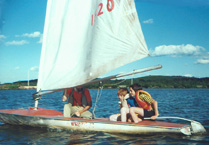 As Wildwood Bluff residents we had space we could use on the Lake Wisconsin shore down the hill from our house, and we kept a rowboat and a sailboat there. Not far away there was a beach on the Wisconsin River that we enjoyed using. In the winter we could put on our skis and go cross country skiing in the woods right behind the house. Across the road from the house was a commons area from which we could hike down a picturesque gorge, something we did with visiting guests from the Prairie UU Society RE program. Closer than the gorge was a place we called the pasque flower bluff where we could see that kind of flower in the spring, and where prickly pear cactus also grew. 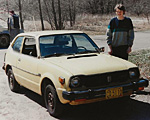 A unique feature of the lake at the bottom of our hill was that, when the ice was thick enough, car races were held on the ice. When the track was not being used by anyone else, I used it to pull boys around the track in a sled with my little Honda Civic. It was also the place where I gave Robin his first chance to try driving. (Learning to drive on ice is a useful skill in Wisconsin.) At left is Robin in 1990 with the 1978 Honda Civic, the first car he drove.
Our water came from a deep well with a submersible pump. An interesting problem with the well appeared when winter brought subfreezing temperatures. We started having a problem with no water reaching the house. Water in the line up from the pump was freezing. Pouring boiling hot water down the wellhead solved the problem, but only temporarily. It turned out that our well was breathing, seasonally. In the spring we could hear air coming out of the wellhead and I found that with the onset of winter temperatures air was being sucked down into the well. I surmised that the well had been drilled down through a cavity that had a pool of water with air above it, and that the water level varied with the season. When air at subfreezing temperatures was sucked down into the well shaft it caused the line to freeze. I was able to solve the problem with a tall old metal wastebasket with a rusty bottom. I knocked the bottom out of the waste basket, placed it over the wellhead, and filled it with sand. This greatly restricted the rate at which air was sucked into the well shaft, and we never had frozen pipes again.
We had a Poynette mailing address, and we were not far from the DNR's MacKenzie Center where we could see wild animals that were recovering from injuries and climb the fire tower shown at right. We did that with Prairie RE kids and with my brother Warren's kids when they were visiting from Minneapolis. It seemed like a good place to raise kids until Ian started attending school in Poynette. Then it became more clear just what a conservative area we were living in. Ian had a T-shirt from somewhere that referenced a geographic location named Hell. Because it displayed that word, a teacher told him he couldn't wear it to school. Another problem was that over time the moisture coming from the concrete walls turned the basement into an area that Barbara was allergic to. Then there was the misdiagnosis from the doctor who told Barbara that she had rheumatoid arthritis, pointing to a future when she could be unable to drive and might need to be closer to medical facilities. Since Barbara needed a house that she was not allergic to, and we wanted one close enough to her job so that she could get there by bus if necessary, we began looking at houses for sale in Madison. With some houses we visited Barbara could tell as soon as she set foot in the basement that she was allergic to it, but we found one on Hammersley Road with a walk-in basement that posed no problem for her. We bought it and moved in while Robin was in his senior year at West High School. That brings me to the last home in my story. As of 2024 we have been here for 31 years. Photos of our house over the years that you can see here illustrate a number of changes. The property had a wooded backyard with flowers planted by the wife who had lived here. An avid gardener, Barbara soon began adding more flowers in back and in front. The loss of a big oak tree in 2005 brought more sun to the backyard, but it also brought more sun than we wanted to the deck at the back of our house. The following year I began construction of a screen porch on the end of the deck that had been shaded by the oak tree. That construction is illustrated in a 22 second slide show that you can view here. Ian undertook a couple of major projects inside and outside the house during his teenage years. He installed tile flooring in the basement bathroom/laundry room. Then he removed the old metal shower booth and began to replace it with a glass sided shower stall. Unfortunately he damaged one of the parts beyond repair, but I was later able to get the shower back in operation by installing a curved bar from which a shower curtain was hung. Ian also installed a series of steps and raised flower beds along the garage side of the house. (Perhaps Barbara will write about the accident she had there.) In the fall of 2006 we took advantage of a federal tax credit and had a domestic hot water solar collector installed on our garage roof. Unfortunately the Wisconsin company that manufactured the collector promptly went bankrupt. You can read the solar collector story here. In 2008 we installed a low power radio station inside the garage which I operated. That station moved to a better location in 2015. You can read the radio station story here and see photos of the installation in our garage here. The biggest change to our house came in 2010 when we had the kitchen remodeled. That project included expanding the kitchen and the eating area next to it by moving the adjacent front wall of the house out about 3 feet. I have posted photos from the remodeling on my Facebook page in albums for inside and outside. A less visible change came in 2020. During the COVID epidemic that summer I replaced much of the supporting structure under our back deck. The previous owner had insisted that the deck be constructed with wood not treated for outdoor use because he did not want the greenish color of treated wood showing through his stain. You can see some of the rot that resulted here. I bought pressure treated lumber and painted it with white primer before installing it. The year 2023 was marked by major changes in front of our house. Hammersley Road was reconstructed by the city, making it narrower, taking away on street parking, and adding a bike lane separated from motor vehicle traffic by a median. I have posted a slide show of the road work here. We opted to plant flowers in the median in front of our house rather than letting the city plant grass. I planted more than 70 irises and a bunch of nodding onions that other gardeners were giving away and Barbara has added a number of nursery plants. In 2024 we lost another big oak tree in a storm. This one was in the corner of our backyard. The top and biggest branch landed mostly in the yards of 3 neighbors. Fortunately there was no damage except to the power and cable lines serving our neighbors one block north. The neighbors and I hauled lots of branches to the curbs on two streets. The biggest pile can be seen in the video clip here. Eventually the city crew came and fed the branches into their shredder. The city piled up tons of shredded wood from that storm in city parks for gardeners to use. I made trips to the nearest location and brought home several loads that we used to mulch around our plants in the median and on the near side of the bicycle path. Fortunately the 3 neighbors affected all use firewood and have chainsaws. Our neighbor to the north has cut up the tree top that fell in his yard and our neighbor to the west plans to cut up the large branch that fell in his yard later.
While I was in the process of building the screen porch mentioned earlier we had a hail storm that caused enough damage to the roof of our house that our homeowner's insurance paid for new roof shingles. We contracted with a local company to do the job, but many other houses were getting roof work done at the same time, so the local company apparently brought in a crew from out of town. It seems they did a poor job of installing one of the vents over the garage because a leak there over the years caused the plywood paneling under the shingles to rot. In the summer I found that rain was causing water to leak into the garage, where it fell into an unused fish tank that I happened to have stored below the leak.
The 2023 Hammersley Road/bike lane project including redoing the first 14 feet of driveway beyond the new bike path for each house | ||
23 In Praise of Bicycles July 15 & Dec. 11, 2024 | ||
|
For years I have made a point of getting around by bicycle whenever I'm not hauling a load that requires a motor vehicle and the weather is favorable. That means whenever the streets are dry and the temperature is 40 degrees or above. However, a few degrees colder are ok if the trip is short, as to the local library or to the home of Gryffindor. Gryff is the furry companion of our youngest son Ian and his wife Layla. I normally bike to his house each Tuesday and Thursday for his mid day walk. My travel mode choice is one of my responses to the global climate crisis. My fuel is the food I consume, and biking also provides exercise I need to stay healthy. Of course I'm not as speedy as I once was, but I can always rationalize when another biker whizzes past me that they must be using an electric bike. If someone asks me when I will be getting an electric bike, I have a ready response: "When I'm too old and decrepit to use a regular one." 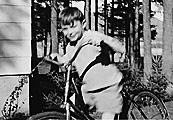 Bikes have been part of my life since I was 8 years old. I lived in a small Canadian town then and only full sized bikes were available. On the back of the photo at right my father wrote "April 25/48 Robert Park learning to ride the bicycle." The photo shows I was learning on a girls bike, probably my sister's, but soon I was riding my older brother's full-sized one-speed bike. Since I could not reach the pedals any other way, I used it by tilting it and putting one leg under the bar to the pedal on the far side. | ||
24 Imperfect but Satisfactory July 29, 2024 | ||
|
Part of my philosophy of life is that "if it is worth doing, it is worth doing well." For any of life's useful tasks, between an outcome of "near perfect" and "good enough" there lies "well done." One summer during my grad student days I joined an eating cooperative at the Catholic student center. This involved shared cleanup chores after each meal. On one occasion, when two young men were assigned to clean up pots, one was so meticulously slow that the other eventually stalked out of the kitchen in disgust before the job was done. Perfectionism is rarely appreciated when it keeps someone else waiting. Some time in the early 1950s, as we settled into our new home in Minneapolis, my little brother Warren took up stamp collecting. I had been given a stamp collection book with spaces lined in for different stamps, and I took it upon myself to create such a book for Warren with lines that I drew in by hand. Not surprisingly, I was too slow with my meticulous effort, and Warren went ahead and stuck his stamps in without my lines. This helped illustrate to me that a job cannot be deemed well done if it is never finished. Over the years I have taken satisfaction in jobs well done. In story #6, Work You Can Believe In, I mentioned how my first boss at the Wisconsin DNR got in trouble with personnel people when he rated my work as "excellent" in several categories in a performance evaluation. In the early years at the DNR we all used WordPerfect as our word processing program. At one point I took up the challenge of creating a WordPerfect macro that would do much of the work needed for a form that had to be filled out with different data for different sources of air pollution. I probably spent more time on the project than would have been approved if anyone had been watching, but it may have been the reason why I later heard second hand that a newcomer to the bureau regarded me as "a genius." In my retirement years I have edited hundreds of audio files for posting on the Prairie Unitarian Universalist Society website and for broadcasting on the low power radio station I have run since 2008. A member of Prairie Society who has operated his own software company was very complimentary about a recording of a panel presentation that I had processed, saying that listening to the recording was better than hearing the presentation in person. Compliments have also come in from listeners to the radio station who have expressed appreciation for the mix of music and talk shows I have programmed. | ||
25 Favorite Foods Aug. 13, 2024 | ||
|
As a boy growing up in Ontario my favorite hot dish made by my mother for supper was sweet potato casserole. A favorite dessert was date bars. That must have been a Leonard family recipe because the summer that my younger brothers and I were sent to an uncle's farm in Manitoba while our father courted his 3rd wife we had the same dessert. Our aunt had made enough so that each of us could have two squares, something I did not know before I had devoured three. Not being much of a cook, before I had my wife Barbara to cook fine meals for me I took advantage of packaged dinners offered in the grocery store freezer. My favorite selection was mostaccioli. I did have one dish I cooked regularly when my kids were young. We called it goulash. It consisted of hamburger mixed with cut up parsnips, zucchini and other available vegetables covered with a mixture of half ketchup and half barbeque sauce. For health and environmental reasons we have not bought hamburger or other red meat for years, but we still have this dish at times when there is zucchini to use, but made with ground turkey. A favorite seasonal food is sweet corn. An energy efficient way of cooking that I have found works well is to steam the ears in the husk in the microwave. They come out hotter than the temperature of boiling water, and it takes less time than it takes to bring a pot of water to a boil. I must not fail to mention the fruit in my diet. One favorite is a muskmelon half with a generous scoop of vanilla ice cream in the center. However, that is a treat I enjoy when Barbara is not at home. She is allergic to melons. A favorite for a hot summer day is fruit salad made with pineapple chunks, grapes, slices of a banana that is not quite ripe, strawberries and other available fresh fruit mixed with sour cream. I like my fruit chilled, and if the fruit salad is put in the freezer for 10 or 15 seconds before serving, that is ideal. Fruit is also good in jello made by mixing packages of two different flavors, one orange and one lemon. Chunks of pineapple and mandarin oranges are key (though grapes and other fresh fruit in smaller amounts can be added) and the juice from the can of pineapple should substitute for some of the water that is used in making the jello. Leafy salads should not be overlooked, but I have often thought that for me, "green leaves do not a salad make." More is needed. Some years ago my son Ian introduced me to ranch dressing, and I like to make what I think of as ranch salad. It starts with a hard boiled egg, sliced with our egg slicer, followed by a generous portion of sliced cucumber and a few carrot slices. Next, pieces from half a ripe avocado are added along with pencil sized srips of turkey ham a couple of inches long, if available. (Unfortunately our local grocery no longer carries turkey ham.) Finally, lettuce and baby spinach leaves are added, topped off with a soft cheese such as Co-jack in chunks about a centimeter on a side. Then you add the dressing, ranch dressing being recommended. Next, there are dishes with a crust, a favorite feature. Some memorable examples are quiche made with beet greens, chicken pot pie, and various dessert pies. During my grad student days there was a fudge bottom cream pie that I always liked to get at the Memorial Union cafeteria, and at home cherry pie a la mode has always been a favorite. Of course holiday meals for Thanksgiving and Christmas are an annual culinary highlight. I look forward to turkey (especially the dark meat) with all the trimmings - stuffing, homemade cranberry sauce, mashed potatoes, etc. - and Barbara makes a sweet potato dish with a topping that is always a hit. And speaking of potatoes, a nice soft potato hot from the microwave is good any time of year as it melts butter under a dollop of sour cream. | ||
26 Catherine Edith Leonard Aug. 19-20, 2024 Click on photo | ||
|
Catherine Edith Leonard was my mother's name before she married my father and replaced Leonard with Park. The first two names come from key women in grandfather Leonard's life. In his Autobiography, when he writes about living in Glasgow around 1890 (the year he turned 19), he says "I cannot pass this period of my life, without referring to a splendid Christian girl called Catherine Robertson that I fell madly in love with. I honored her memory for about fifteen years after her death, and Catherine our oldest daughter carries her name spelled in exactly the same way." Further along he writes "Then came the glorious fourth of October (1910) when I was married to the W.M.S. Missionary, Miss Edith A. Weekes B.A....." Finally he says "In the Methodist Church Hospital in Pakan ... on July 31st 1911, our Catherine was born. When Mother and Baby were ready to come home, they had a forty mile buggy ride to reach Lamont C.N.R. Station. I hurried from my work to meet the train at Edmonton, missed my Family, but Edith's brother Abel met them and all was well. Now we are three, so life grows brighter, so did Catherine, a Baby to be proud of." Grandfather Leonard's Autobiography ends before he and Edith were appointed to missionary positions in China by the Canadian Methodist Church in 1914, but Edith created a record book for Catherine that describes that period in her life. Excerpts with photos have been posted here, and the full record book is available here. After Catherine died my father added 2 pages at the end of the baby book she had prepared for me years earlier. He gave her birthplace and date as Alberta Canada, July 31, 1911 and said the following: "Mother went with her parents to China before she was two years old. Her parents were missionaries at Chengtu. He was a builder of the mission buildings. Mother returned to Canada for a year or more when her parents were on furlough but returned with them to China again. She spent about 13 yrs in China and got her early schooling there. She could speak some chinese. Mother & her parents returned to Canada & Mother's high school days were at Tillsonburg, Ontario. She was a brilliant student and received a medal for her high school distinction." "Mother became a high school teacher and taught school for a few years before marriage. She could read latin, read and talk French and a couple of years before her death she learned to read and speak Spanish. Mother was a devout Christian and made her religion a living part of her life. She was much loved by all who knew her and had many true friends. She was a woman who knew real joy in the beauties of nature. She loved art and poetry. She wrote some poetry and it usually reflected her appreciation of beauty and God's presence." My mother's poems as collected by my father are posted on our family website here. She also liked to write descriptions of what she saw on vacation trips with my father. On the Family Recollections page of the website you will find what she wrote about trips to California (1948), Florida (1949) and Louisiana (1951-52). In the first of these she tells of meeting a famous Indian potter, Marie Martinez, and describes her pottery making process. I have the notebook in which she wrote these 3 accounts.
Details from my mother's childhood are to be found in the record book by her mother mentioned above: It includes specifics about her birthplace. Even though her birth certificate gives her place of birth as Edmonton, her mother's account gives the place of birth as the George McDougallHospital in Pakan Alberta, some miles away from Edmonton. Pakan was apparently named after Chief Pakan of the Woods Cree Indians. Its earlier name was the Victoria Settlement (or Fort Victoria), and in recent years it has been named as aProvincial Historic Site as described at https://victoriasettlement.ca/about. Further, as of 2001 Victoria District is a National Historic Site of Canada as shown at https://www.pc.gc.ca/apps/dfhd/page_nhs_eng.aspx?id=1960. Methodist missionary George McDougall is mentioned there. See also the Wikipedia page here. Shortly before writing this account I was fortunate to receive a response to an email enquiry which included photographs of the George McDougallHospital. The email said "The research I have indicates that the George McDougall Hospital in Pakan was originally built in 1907 on river lot 8 (just a wee bit west of the current provincial historic site). It sounds like it was considered up to date and was furnished with lots of modern equipment. In 1918, the railway arrived in Smoky Lake, some 14 km north of Edith's account says "Catherine remained two weeks in Pakan. Her first outing was a long drive in a high old fashioned buggy with two smart horses...." and continues "On to Lamont for supper ... then aboard the train for Edmonton." "C's Uncle Abel met us first, then along came father with a horse and buggy and we were soon home." Edith goes on to say "In the spring of 1912 (March, with snow on the ground still) we went to Kolokreeka for father to do some building." "After five weeks we went back to Edmonton because among the Ukrainians we could not get good fresh milk." "In September we went to Vegreville to stay with Uncle Tom and Aunt Ada until Etheridge was born in December. Shortly after returning to Edmonton in Jan'y Cath learned to walk. She had almost learned in Vegreville when a severe attack of measles undermined her courage. She and Harold were both very sick, and a few weeks later both had a second attack. In Jan. however she learned to walk and run all in one evening." Later the record book says the family bought a home in Delhi Ontario in October of 1925, where Catherine finished Continuation School. Then she went to high school in nearby Tillsonburg 1925-29 for Upper School, "winning the 3rd Carter scholarship ($40)."
The record book continues with photos from Catherine's years as a teacher, her marriage to Wilford with the two small children he brought with him from
Of Catherine becoming his new mother Douglas wrote in his memoir (online at http://parkscrapbook.us/DWPARK/memoir/index.htm), that "a remarkable lady, Catherine Leonard Park became the mother I really knew. I say remarkable because this woman had never been married and had to step into another woman's shoes in another woman's house where a family of two rambunctious children were busy declaring their independence. I must have been a handful as an inquisitive, carefree child." Betty had more to say in her memoir, including the following: "My father met Catherine Edith Leonard in the summer of the year his mother Lura died. She was a young schoolteacher, a bare twenty-three, willowy and withdrawn, an opposite from his exuberant [first wife] Lila." Catherine had "pale skin brushed by blush when touched by sunrays, and her eyes were the colour of forget-me-nots, pure though sometimes darker." Betty went on to say "Being somewhat cloistered she knew nothing of men, not even a romanticized version. As we became friends in later life she confided that she had never been kissed nor was she till after my father proposed and an agreement was struck. She’d been playing tennis that first day she met him in his father’s house and he saw a white skirt, nice legs and wide generous smile, slow and sincere. She had a non-judgmental acceptance of things behind the quiet reserve and there was that understanding of colour and sound and space from which dreams are woven and she appreciated her inner escapes and valued them and smiled with them, alone in her own solitude till near the end of her life. Did my father see all this when he met her. I think rather he saw a suitable helpmate to raise his children, a goodly woman guileless and gentle. The disorganization, impracticality and tardiness came later." "After the wedding the real work of the marriage began. As in an arranged marriage you absorb the shocks, you swallow the surprises and live with the newness of yourself. Catherine was no longer the French teacher, she was a mother of two young children, she was the village doctor’s wife. She slept in the same bed as had her predecessor. She slept with the same man, looked each morning in the same mirror, took hair pins out of the same drawer and could not escape from the picture of her predecessor which still hung on the dining room wall downstairs. So Catherine gazed some more at the image of herself in the tall winged mirror which could be folded at the sides to show front and back and she wondered." "The village gave Catherine leeway and eventually her youthful reticence and her appreciation of friendship endeared her to the watchers and she truly loved my brother and myself. My father had chosen well. She delighted in small things like found feathers and pearl buttons and seemed to be willing to learn the intricacies of housekeeping with the help of Muriel the hired help. Oddly she could drive a car, an uncommon skill for women of that generation though she never did again after the family moved from country roads. So in Brownsville she had some independence which she seldom used being tied to the household and her dreams." "One of her first acquisitions was a piano to go along with her violin. My father soon added an ocarina and a mouth- harp, instruments easily learned by the musically uninitiated. So she endeavored to continue her musical heritage with small musical contributions offered at church socials."
As explained in story #1, The Forgotten Birthday, my mother died of cancer One of the things I benefited from while growing up was my mother's patience. I remember once, while we were living in Whitby Ontario and I was still young enough to take afternoon naps, I took a crayon with me when I was sent to take a nap in my parents' big bed. Instead of sleeping I drew on the sheet with the crayon. I don't recall my mother being angry, but it may have been soon after this event that naptime became a thing of the past. Since she did not have a job outside of the home, my mother was there much more of the time than my father, but when they were both there I guess my mother deferred to him regarding child-related decisions. I don't recall them ever discussing such things in front of us kids. Our father did not have as much patience. I recall one time in Deep River Ontario when I had some minor dispute with another kid in the neighborhood. My father jumped on the occasion to teach me something, I guess. Never having tried to instruct me in self defense, he pulled out two pairs of boxing gloves from somewhere and insisted that I and the other boy put them on. The other boy knew just what to do. He immediately punched me square in the nose. I had never experienced such pain in my life, and the unwanted boxing match was over. My mother may have had some words in private with my father after that, but if so I never learned about it. | ||
27 The Annual Escape Aug. 27 & Oct. 23, 2024 | ||
|
When I was in grade school and junior high school what I looked forward to most was summer vacation - a time free from the pressure and tension of school. (See story #12 School Days.) I enjoyed family vacation trips (see story #5 Vacation Memories) but I also enjoyed relaxed time alone to do whatever struck my fancy. In Deep River Ontario I used a wagon to haul clay from a nearby creek bed to build a clay highway for my toy car across the sandlot at the end of our block. There in the winter I enjoyed exploring the woods surrounding the town on skis. With my brother James (thinking about summer again) I enjoyed walking to the nearby beach for a swim.
The canoe was a Peterborough canoe, from Peterborough Ontario, that moved with us from Deep River to Minneapolis. There is a Wikipedia page about the Peterborough Canoe Company here which notes that the "original boats are now prized as antiques ... by hobbyists." The company ceased production in 1961 but there is now a Peterborough Canoes and Watercraft Facebook group. | ||
28 Tax Inequities Sept. 21, 2024 | ||
|
When I first came to the U.S. in 1949 the highest marginal tax rate for individuals was 91%, increasing to 92% for 1952 and 1953, and reverting to 91% for 1954 through 1963. Since then the richest Americans have seen to it that their wallets are getting fatter and fatter. The top tax rate was 77% in 1964, 70% for 1965-1981, 50% for 1982-1986, 38.5% for 1987, and 28% for 1988-1990. Small increases in subsequent years ranged no higher than 39.1%. The corporate tax rate was 52.8% in 1968 and 1969 but only 35% in 1993, falling to 21% in 2017. These tax inequities have produced a major shift in wealth to the super rich from the rest of us since I came to this country. I believe it is the proper role of government to tax fairly and spend wisely. I think all of us with incomes above the national median income should be taxed more, with the income tax rate increasing with the level of income much as it did when I was a child. I feel that no one on this planet truly earns a million dollars a year. The fact that such incomes are legal reflects how distorted our economic system is. I would like to live in a society where the lowest income earned by someone doing useful work and the highest income differed by no more than a factor of 10. The shameful situation we are living under at present is illustrated by the following graph from inequality.org. | ||
29 My Feelings about Movies Oct. 14, 2024 | ||
|
I'm not a fan of action movies that feature guns, bombs, or other violence. I like movies that have something important to say and do it in a sensitive, artistic way. Favorites would include To Kill a Mockingbird, South Pacific, and The Sound of Music. A film you may not have heard of, Nothing But A Man, holds a special place in my memory because I saw it with "the girl with the golden smile" (story #11). | ||
30 On Raising Children Oct. 28, 2024 | ||
|
Every child is an individual person. To start, my advice is to pay attention to the differences between your children and gear your parenting accordingly. At the same time, you want all your children to see that all are being treated fairly. My general advice: exercise patience, share parental responsibilities with your spouse, be ready to listen, always set a good example, and explain your actions when discipline is needed. In the early years, both parents should share diaper changing, bathing, feeding (once solid food is being consumed), and bedtime story reading. When a preverbal baby wants to show you something, be clearly interested. Once he or she starts talking, take time to listen to the tales of joy and woe. When conflicts arise, demonstrate patience in reaching a fair resolution. Set the boundaries needed for family welfare with family rules and explain those rules, even to children when they are too young to fully understand. When Barbara and I were married and rain caused our guests to crowd into our living room, my oldest son Robin was hitting another child over the head with a large soft couch cushion. My father took the cushion away from him, telling me that he could injure the other child's neck. I asked him if he explained to Robin why he was taking the cushion. He said "no, he wouldn't understand." That was not good parenting on my father's part. | ||
31 Computers and Me Nov. 6 & 17, 2024 | ||
|
My introduction to computers came during the 1960s when I was a graduate student in chemical engineering at the University of Wisconsin-Madison. We were encouraged to take a class introducing us to the Fortran language. This was the era of computer punch cards, and we grad students were allowed time on a university mainframe computer to carry out calculations related to our research. I had a box of punch cards containing the output data from some runs I did with the help of another grad student, but I never learned enough Fortran to be able to do programming myself. Personal computers came next, starting with the Vic-20 in the early 1980s. Barbara and I were living in her new house by Lake Wisconsin by then. The Vic-20 was our first home computer, and was used by our 3 boys and me. A TV set served as the monitor and games came on cartridges that could be plugged in. Commands you typed in on the keyboard showed up at the blinking cursor on the TV screen, and you typed "run" to start a game or another program. As a result, "run" was the first word Ian, our youngest, learned to spell. The Vic-20 had very little internal memory, but you could write a program in BASIC and save it on an audio cassette using a plug-in attachment that handled cassettes. The large rectangular cursors could be programmed into multi-colored images, something I enjoyed doing. Our Vic-20 made a public appearance at a computer fair I organized at Prairie Unitarian Universalist Society as explained in the following article from the congregation's February 11, 1986 newsletter.
On display at the Computer Fair was a 1-player ski racing game that Robin had programmed for the Vic-20 from code he got from the back of a book on the BASIC computer language. He also programmed a computer display to accompany the song "Magic Penny." The computer lab at Mischa's elementary school was also equipped with Vic-20s. The school had an after school program for Talented and Gifted students run by parent volunteers, and once a week during the 1986 spring semester I helped with a 1-1/2 hour computer lab session for Mischa and a number of his classmates. I also got to spend time with Robin in his school's computer lab that semester. That first computer was followed by a somewhat more advanced computer from the same company, the Commodore 64, which had an external disk drive for reading from and writing to 5-1/4 in. floppy disks. We accumulated disks with SID music and a large collection of games. By 1987 I was using that computer to compose and print out correspondence. At one point I put on a program at the high school in the nearby town of Poynette on how to use these home computers, borrowing a neighbor's Commodore 64 for the event. Afterwards I watched for a light in that neighbor's house each night as I passed by on the way home. I finally saw a light there about a week later, put the computer in a grocery bag and took it back. The husband who had loaned me the computer was not home but his wife was, so I handed the bag to her. She glanced in the bag and immediately began talking about something totally unrelated. About a year later I saw the husband at a party and was shocked when he accused me of never returning his computer. Thinking about it later, I wondered whether the computer in a paper grocery bag had accidentally been thrown out with the trash. On the other hand, perhaps the wife was unhappy with how much time her husband had been spending on the computer, and took the opportunity to correct the situation. 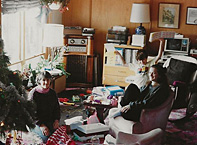 In a June 10, 1987 letter to Warren I wrote "I have a tape copy of the SpeedScript 3.1 wordprocessing program for the Commodore 64 now. It is much closer to a full featured wordprocessor than the simple VIC-20 program I used last time I wrote. This is my first letter using it." Robin remembers using an Apple II+ computer that came to our Lake Wisconsin home from somewhere, but neither of us can remember where it came from. I don't think I ever used it, but you can see it in the background of the 1989 Christmas photo at right. In the early 1990s Robin and I each joined in an upload contest for Commodore 64 users run by a local couple. The was the era of internet bulletin boards that we connected to with a dial-up telephone connection. A second prize of $100 was awarded to someone but a piece of equipment worth more than that was the first prize. I participated by uploading music files, which were small and easy to upload. I was going to be away on vacation before the contest ended, but I uploaded many files before I left. When I returned I found that I had uploaded a much larger number of files than anyone else. They were probably not the kind of files the contest organizers were looking for, but they had not specified. In any case, they refused to award me the first prize, falsely claiming that I had shared my password with Robin and that he had uploaded some of the files that actually came from me. After our family moved to Madison late in 1992 other computers followed. My first MS-DOS computer was an Amstrad PC-20 with an internal 3-1/2 in. floppy disk drive but no hard drive. In November of 1993 I got an internet connection that provided access to websites, and the following month I was able to start sending Xmas messages by email as well as by "snail mail." My Wisconsin DNR job provided me with my email address at the time, parkr@dnrmai.dnr.wisc.gov. I developed a great interest in MIDI music and was delighted to find that we had moved in two houses away from the past chair of the Music Department at the University of Wisconsin. He was using MIDI and had state-of-the-art equipment including a Kurzweil K2000R digital synthesizer connected to a full sized Fatar keyboard. He was most generous in letting me try out the system and borrow its manual. He said whatever I learn about the system he didn't have to. By December of 1993 Barb had recorded the bass part of a choir piece on the computer so that I could practice it at home before singing it in the choir at Prairie UU Society (which she conducted). In July of 1994 we invested more than $2000 in a new multimedia Windows computer. Ian and I enjoyed experimenting with the different things it could do with sound and graphics. It had, built in, a 3-1/2 in. floppy drive, a CD-rom drive, and a Zip drive. At the time the latter seemed like the coming thing, using thick disks with a capacity of 100 MB, but in a few years they became obsolete. By the end of 1994 I had a collection of close to 2000 different MIDI songs which could be played by on the computer or on a MIDI keyboards connected to computer. In the summer of 1995 I invested $6 in a garage sale Amiga computer to experiment with. I got it playing modular music files through a stereo system set up in Robin's old bedroom in the basement. Moving on from MIDI files I soon had a collection of music in mp3, muz, krz, lzh, rme, s3m, sng and other formats. Other computers have come and gone over the years since then. Barbara had an Apple laptop but I have stuck with Windows computers, which I was familiar with from my DNR job. Email became my primary means of communicating with people that I did not get to see routinely. For a time my email address was rwpark@juno.com but it was replaced with rwpark@loonfoot.com and later loonfoot@gmail.com. The last two are related to LoonFoot Web Designs which was founded as a father/son partnership with Ian in June 1999. Designing websites became an important hobby for me, especially the big Park Family Scrapbook where this story is located, a major family history project. For our family reunion in 2001 I made copies of it on CD-roms. In 2004 http://parkscrapbook.us was established as the home for this project. | ||
32 The Shirt that Never Returned Nov. 18, 2024 | ||
|
Prompt: Write about a memorable incident from your college years. During my grad student days in Madison a favorite social activity was participation in the weekly gatherings of international folk dancers on campus. The group met on Sunday nights, and for most of the year we danced at the Hillel Foundation on Langdon St. However, during the summer when the weather was good, we moved our dancing to the library mall. On one of these warm summer nights, after dancing on the mall had ended around 9 PM, I walked across the street to the Memorial Union pier with Debbie Doob, the grad student who was to become my first wife. We were near the end of the pier when a swimmer came up the ladder. It was a coed wearing nothing but a bikini bottom who immediately became very upset. She explained to us that she had been wearing a halter top borrowed from a friend that she did not want to get wet, so she had left it on the pier. While she was swimming it had disappeared! She asked to borrow my shirt so that she could get home. I was wearing a short sleeved shirt over a white v-necked T-shirt. I took them off and, not wanting to give up my shirt, offered her my T-shirt. She gratefully put it on and disappeared into the night. No doubt she soon met with her friend and told her how terribly sorry she was to have lost her halter top, but she had an adventure recount. Perhaps she offered her my T-shirt as a lame replacement for the lost halter top. On the other hand she may have saved it as a souvenir from her college days. She may well have her own grandchildren by now. Perhaps she has a granddaughter who just entered the UW as a freshman this fall. I can see her taking out the souvenir to show the granddaughter, saying "I have a story to tell you about this T-shirt." | ||
33 The College Researcher Dec. 4 & 16, 2024 Click on photo | ||
|
My first opportunity for independent research came toward the end of my undergraduate time at the University of Minnesota. The Chemical Engineering Department there had some funds from a National Undergraduate Research Participation Program, and I got a small stipend and some space in the building to do a project during the summer of 1960. I decided to study oscillating soap bubbles. First I needed to find a way to create durable soap bubbles which would last long enough to be experimented on. I tested different liquid solutions by blowing soap bubbles and floating them out a 2nd floor window. I can imagine how impressed passing observers on campus were concerning the serious research going on in the Chemical Engineering building. The solution for making bubbles that I settled on was a mixture of Prell shampoo concentrate and glycerin. My experimental setup used a tall clear plastic tube about a foot in diameter with a speaker at the bottom to provide sound input of tones that I could set to different frequencies. The bottom of the tube was filled with heavy freon gas, with air in the top half. This allowed my soap bubbles, a few inches in diameter, to be floated down from the tube's top until they reached the freon layer, where they stopped. Then I could film the free floating bubbles as I made them oscillate at different tone frequencies. It was fascinating to see how some higher frequencies would make bulges around a bubble go in and out. When it came time to choose a graduate school I looked at the areas of research that different potential major professors were proposing. Research on droplets proposed by a chemical engineering professor at the University of Wisconsin in Madison caught my eye. Perhaps my bubble research nudged me in the direction of droplets. Both are spherical, when they are not oscillating, after all. Besides, I've always enjoyed watching waterfalls as the water droplets rush by, interacting with each other. So I decided to study colliding water droplets at the University of Wisconsin. I designed an experimental study to address the fundamental question of "what happens when water droplets collide under different conditions?" To do a quantitative study I needed to develop a way to produce and observe controlled collisions. Studying the literature to see what others had done was the first step. I found more than 400 articles to read, going back as far as 1833 when a researcher found that vibrations could cause a stream of water to break up uniformly, giving equally sized equally spaced drops. That became my approach as I developed the equipment described in the 1965 article published with my major professor which you can see at http://parkscrapbook.us/RWPARK/FILES/WRITING/device.pdf. To produce controlled collisions it was necessary to work with droplets that were not oscillating, and it quickly became apparent that this meant that the droplets had to be small. When a liquid jet breaks into droplets they start out oscillating and need time for the oscillations to damp out. The larger the drop the longer the time needed and the greater the distance the drop will travel while oscillating. The result was that I needed my colliding drops to be less than 1 mm in diameter.
My spot in the basement was picked because there were ports in the first and second floors above that I used. I had found that dissolved air in the water interfered with the production of regularized streams of drops, so I used distilled water that had been degassed by stirring it overnight in a large bottle under vacuum. Naturally I didn't want to use a tank pressurized with air to get the pressure required to produce the tiny streams of water.I needed. The solution was to place my bottle of degassed water in a lab on the third floor, running the water down to the basement in a tube through the ports in the floors. You can read a brief description of my research in the abstract at the beginning of my doctoral dissertation. I generally conducted my experimental runs in the evening, coming in after supper and often not leaving until 2 AM. I had access to a Ditto machine that I used to make data forms that I filled in. Still photos were taken with a Polaroid camera because that enabled me to use the highest speed black and white film that was available at the time. High speed motion pictures were taken with a Dynafax rotating drum camera capable of exposing 16 mm frames on a strip of 35 mm file about 34 inches long at rates of up to 35,000 frames per second. Two other cameras were used for making illustrative motion pictures on 16 mm film. They exposed a 100 foot reel of film in about 1 second.
For each quantitative run I used the Polaroid camera to photograph the way the equipment was set up. I then taped that photo into a hardcover My 1970 graduation was followed by a brief postdoctoral appointment in the Chemical Engineering Department. Some years later I met with Prof. Bob Bird and learned that some 16 mm films and the last of my research notebooks had been discovered on top of a cabinet in the Chemical Engineering Department, apparently left there by the grad student who had followed me under the same major professor and extended my research with a slightly revised version of my equipment. Asking about my other research notebooks I was told that Bob had heard from another professor that these notebooks from numerous grad students had been stored in a bookcase in a lounge area. Apparently, when the bookcase was wanted for some other purpose, all the research notebooks were dumped in the trash! My 36 pages of Volume 4, shown here, may be the only research notes in department issued hard cover volumes surviving from that period. My major professor died in 1991. The article about him here states "Professor Crosby's early interest in atomization and spray-drying phenomena resulted in the first fundamental study of controlled collisions between pairs of drops using high speed cinematography," an evident reference to my work as his grad student in the 1960s as described above. | ||
34 More Hindsight Dec. 30, 2024 Click on photo | ||
|
In the first half of my senior year in high school, at age 16, I was informed by my chemistry teacher, Mr. Norton, that I was that year's winner of the Bausch and Lomb Honorary Science Award for my high school, as mentioned in story #12, School Days. Along with that award came an opportunity to apply for a scholarship to the University of Rochester in New York. I was not particularly interested in going there, but I decided to apply for the scholarship anyway. The application process required the submittal of household financial information. Since the household at that time included my father and stepmother, both of whom were working, information about both of their incomes was needed. My stepmother was incensed that she would be asked to provide such personal information. By the time I was 20 I had my first car, as shown at right, but I was still living in the family home shown in the background. Good advice for me at that time would have been to check with my friend Dave to see if he would share an apartment with me for our final year of college as undergraduates. |





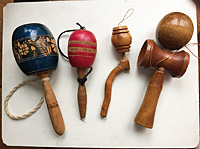
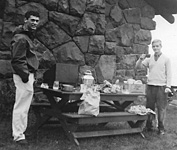


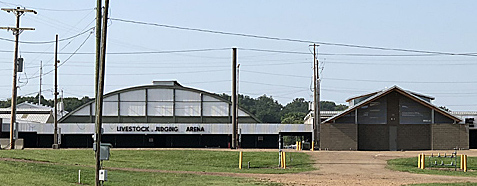 The police brought up a series of trucks, loaded us in, and took us to the state fairgrounds a few minutes away. With the other male prisoners I was held in the round topped fairgrounds exhibition hall shown at right for 10 days on the charge of parading without a permit. I have described the violence by police, who had their badge numbers taped over to prevent identification, in the letter I wrote at the time, posted
The police brought up a series of trucks, loaded us in, and took us to the state fairgrounds a few minutes away. With the other male prisoners I was held in the round topped fairgrounds exhibition hall shown at right for 10 days on the charge of parading without a permit. I have described the violence by police, who had their badge numbers taped over to prevent identification, in the letter I wrote at the time, posted 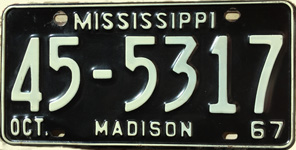 for one semester. Mississippi plates include the county of registration. Tougaloo happens to be in Madison County, which is why that name appears on the plate shown at right. The job came with a faculty apartment on campus, and I had little use for the car once I was there. I drove into Jackson once for a haircut. Haircuts were $1 at a barber shop where the large front windows had been replaced with plywood. (That proved to be my last visit to a barber shop. Ever since then I have cut my own hair.) Tougaloo students who were doing civil rights organizing in surrounding rural areas asked to borrow the car, and that's the main use it got while I was at the college.
for one semester. Mississippi plates include the county of registration. Tougaloo happens to be in Madison County, which is why that name appears on the plate shown at right. The job came with a faculty apartment on campus, and I had little use for the car once I was there. I drove into Jackson once for a haircut. Haircuts were $1 at a barber shop where the large front windows had been replaced with plywood. (That proved to be my last visit to a barber shop. Ever since then I have cut my own hair.) Tougaloo students who were doing civil rights organizing in surrounding rural areas asked to borrow the car, and that's the main use it got while I was at the college.


